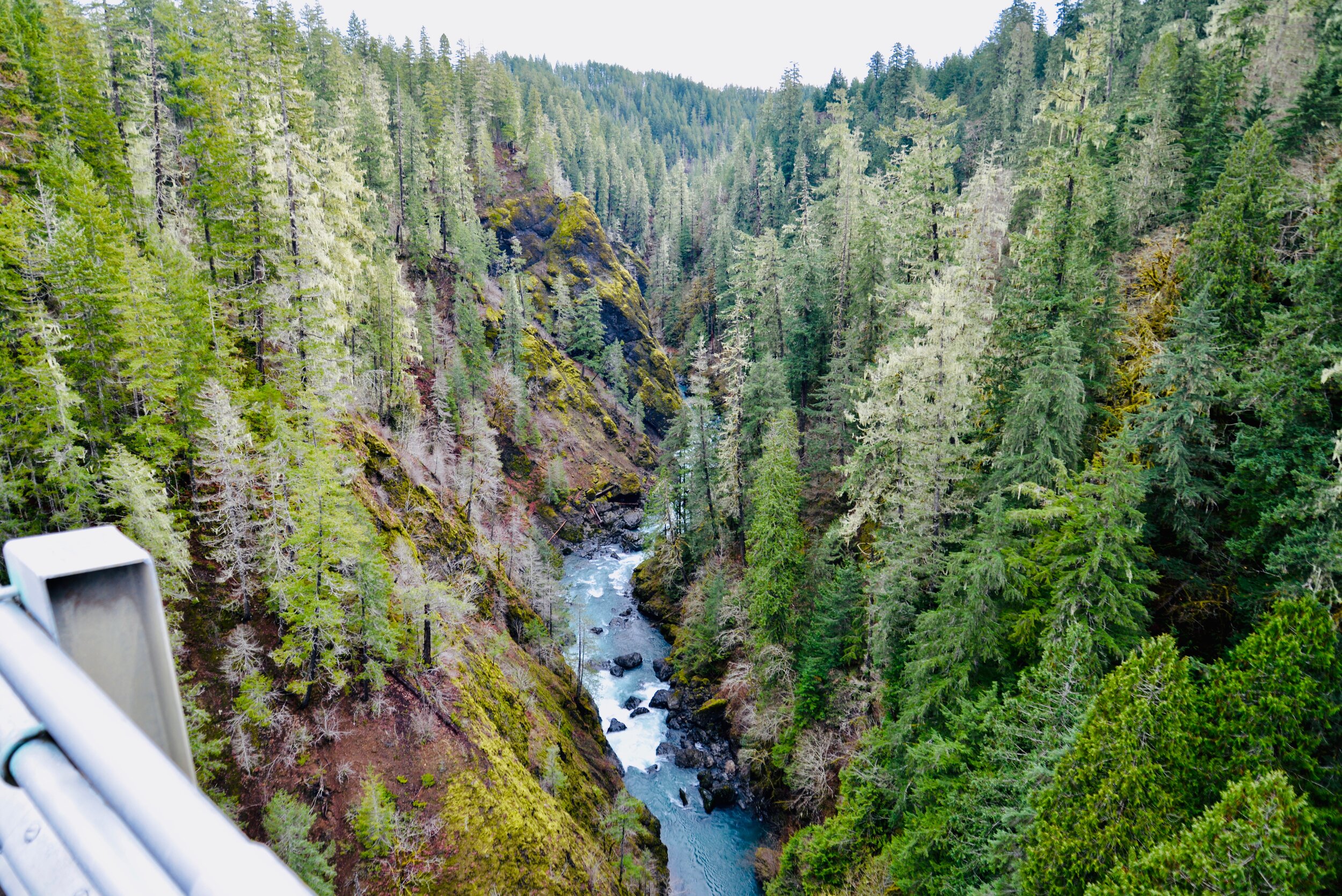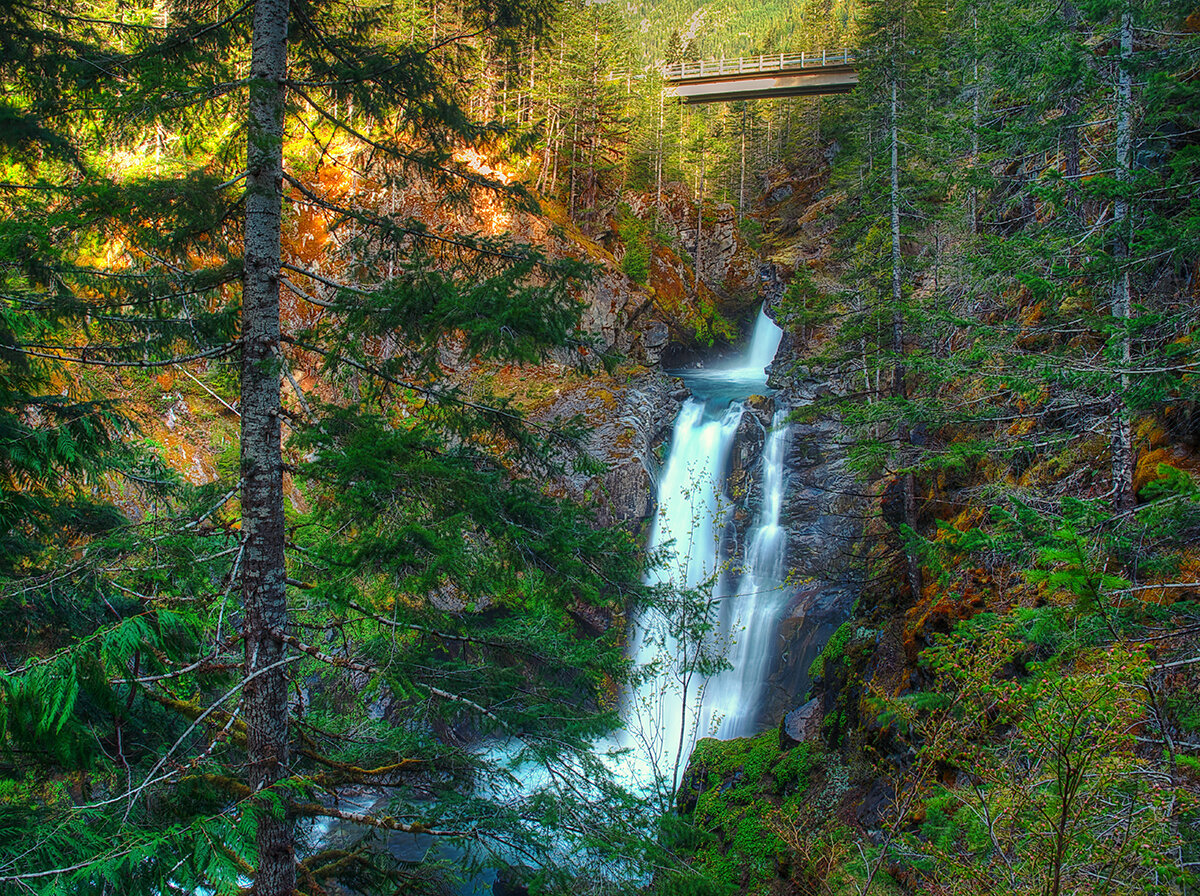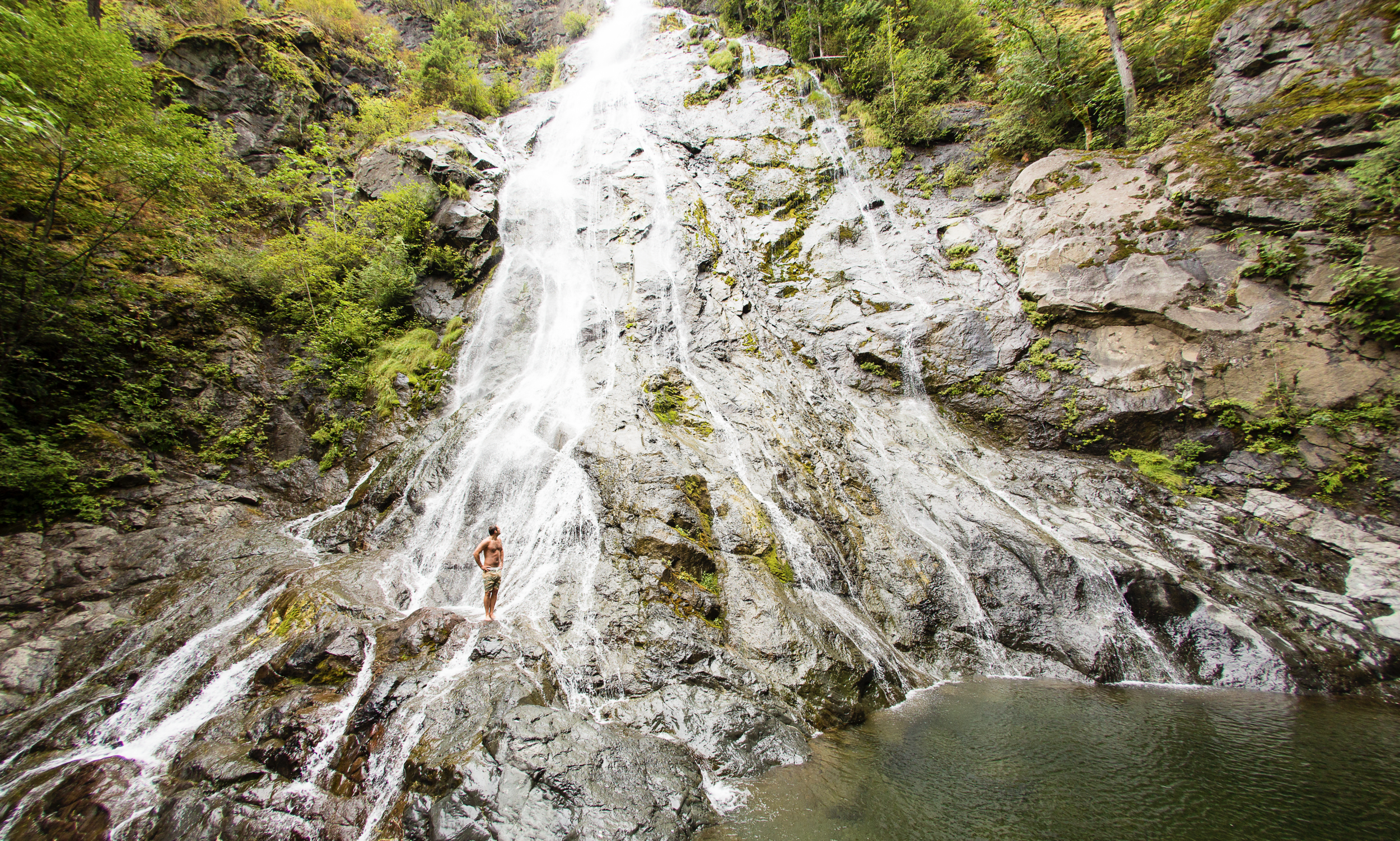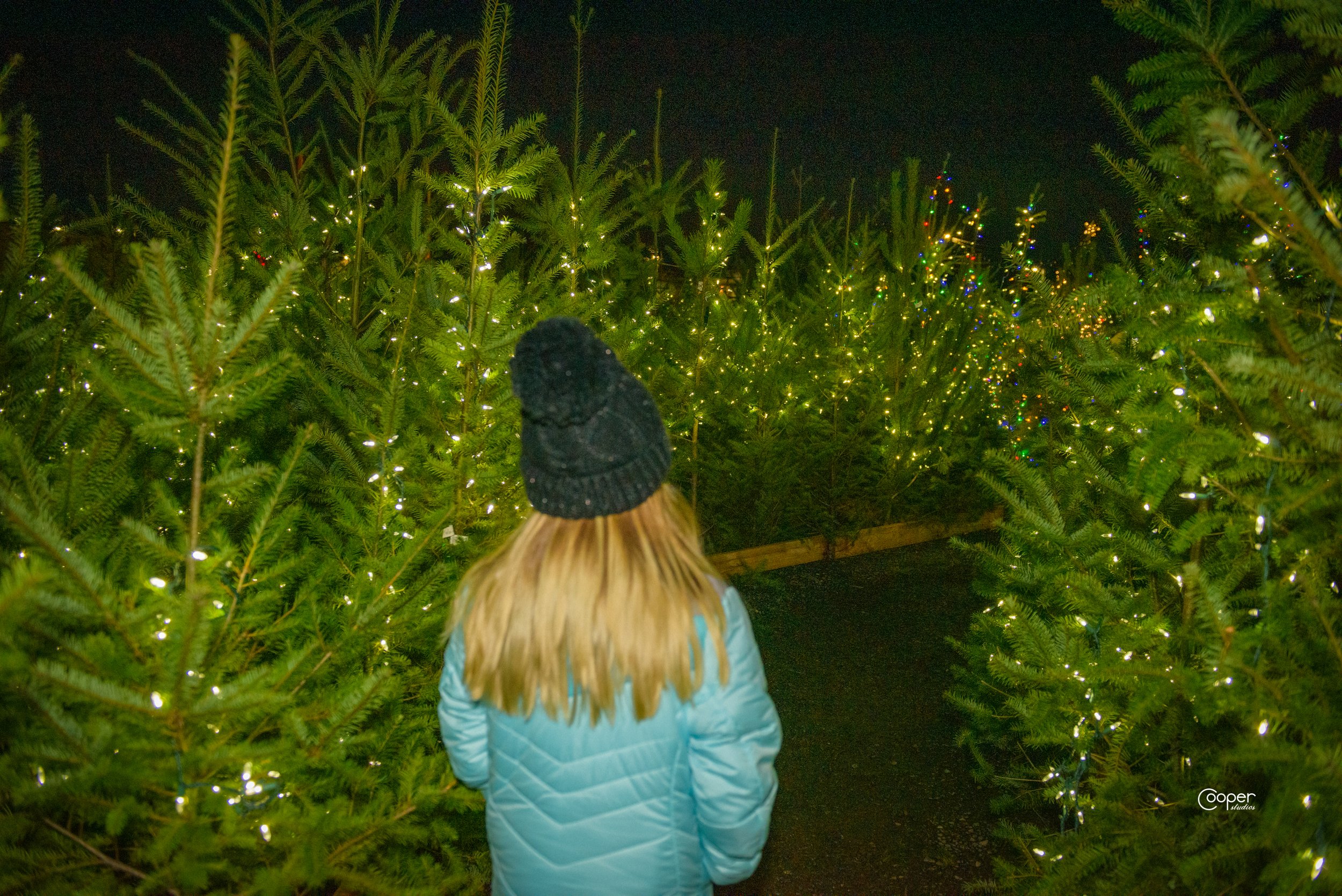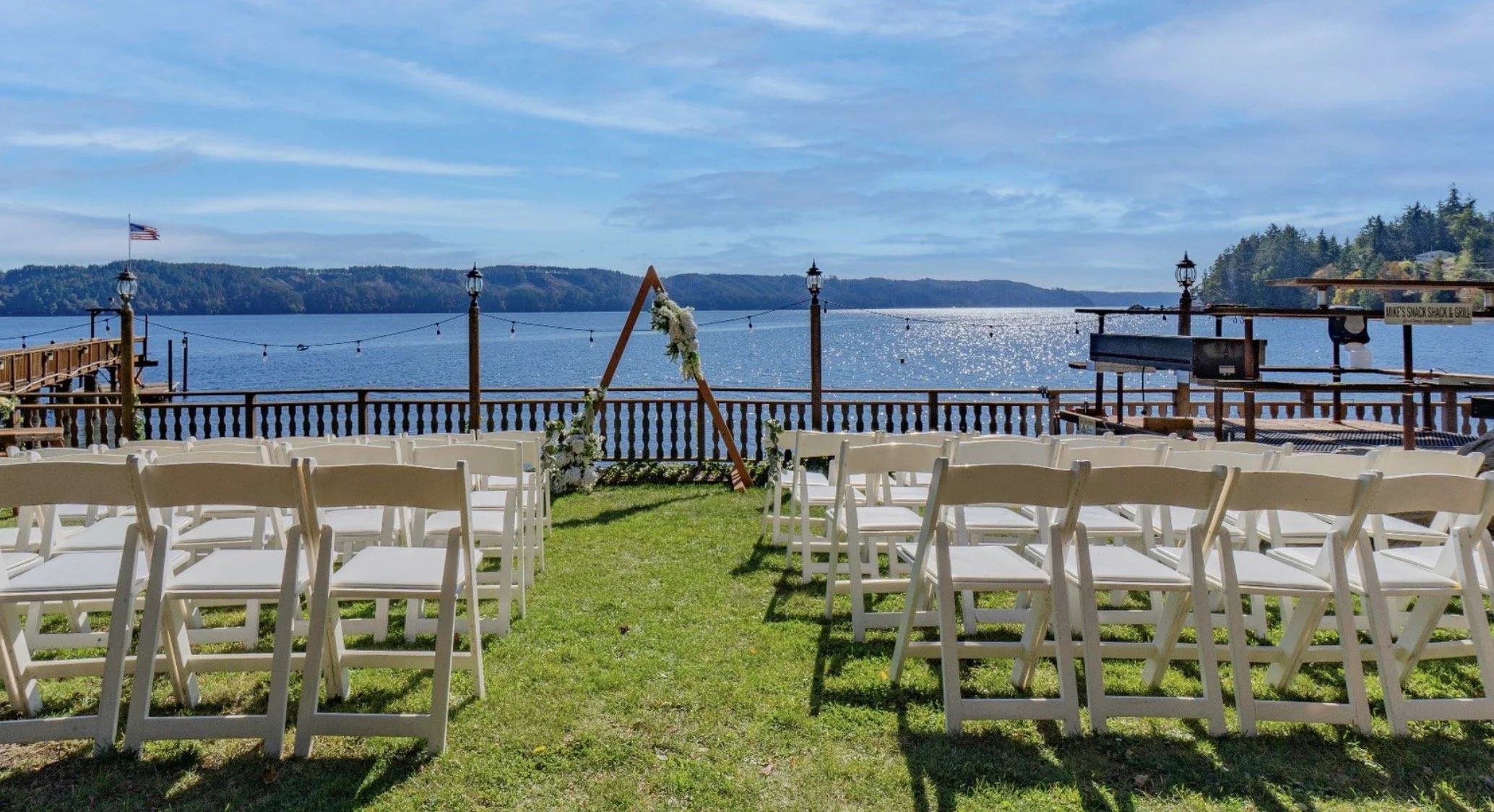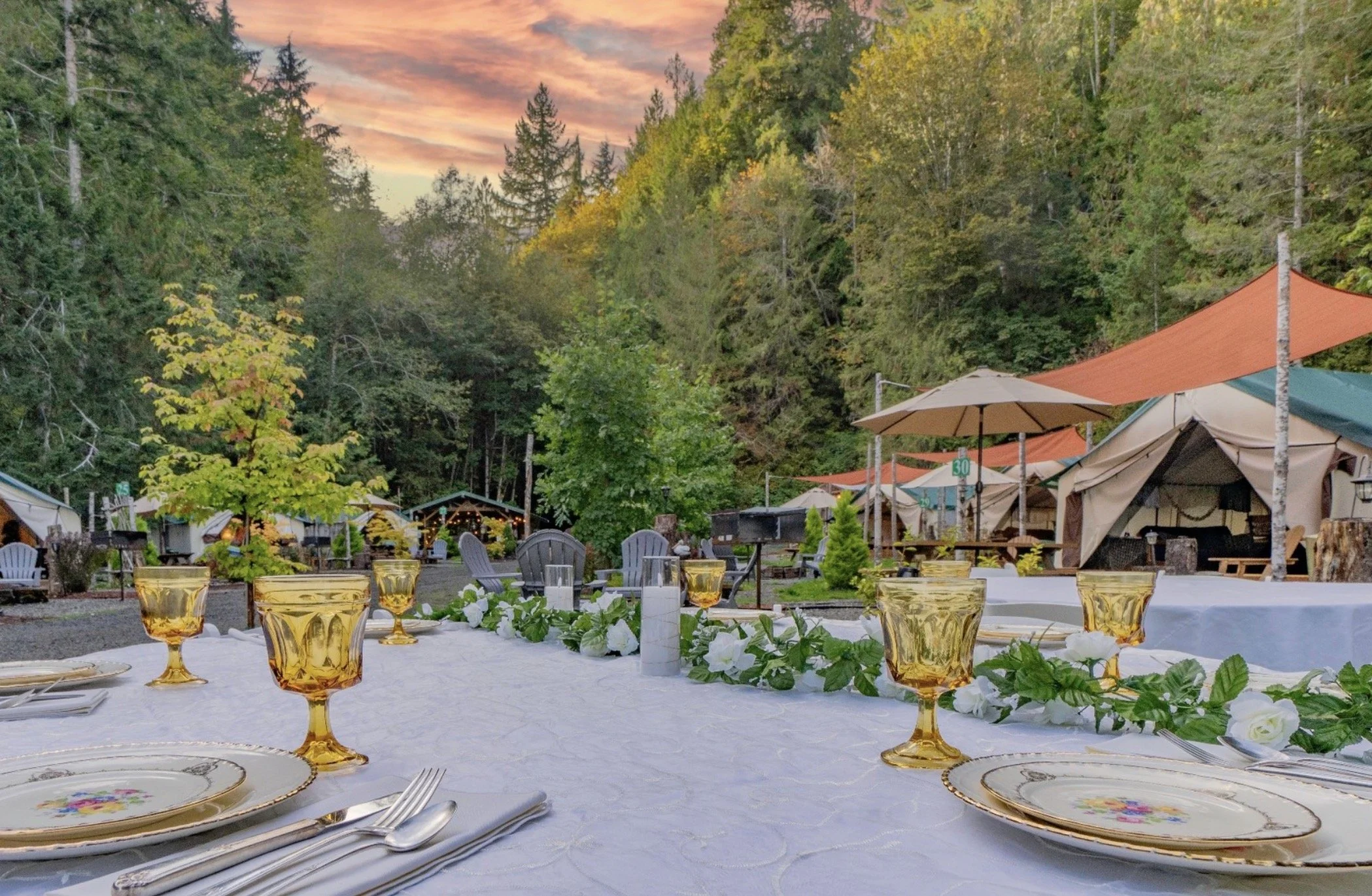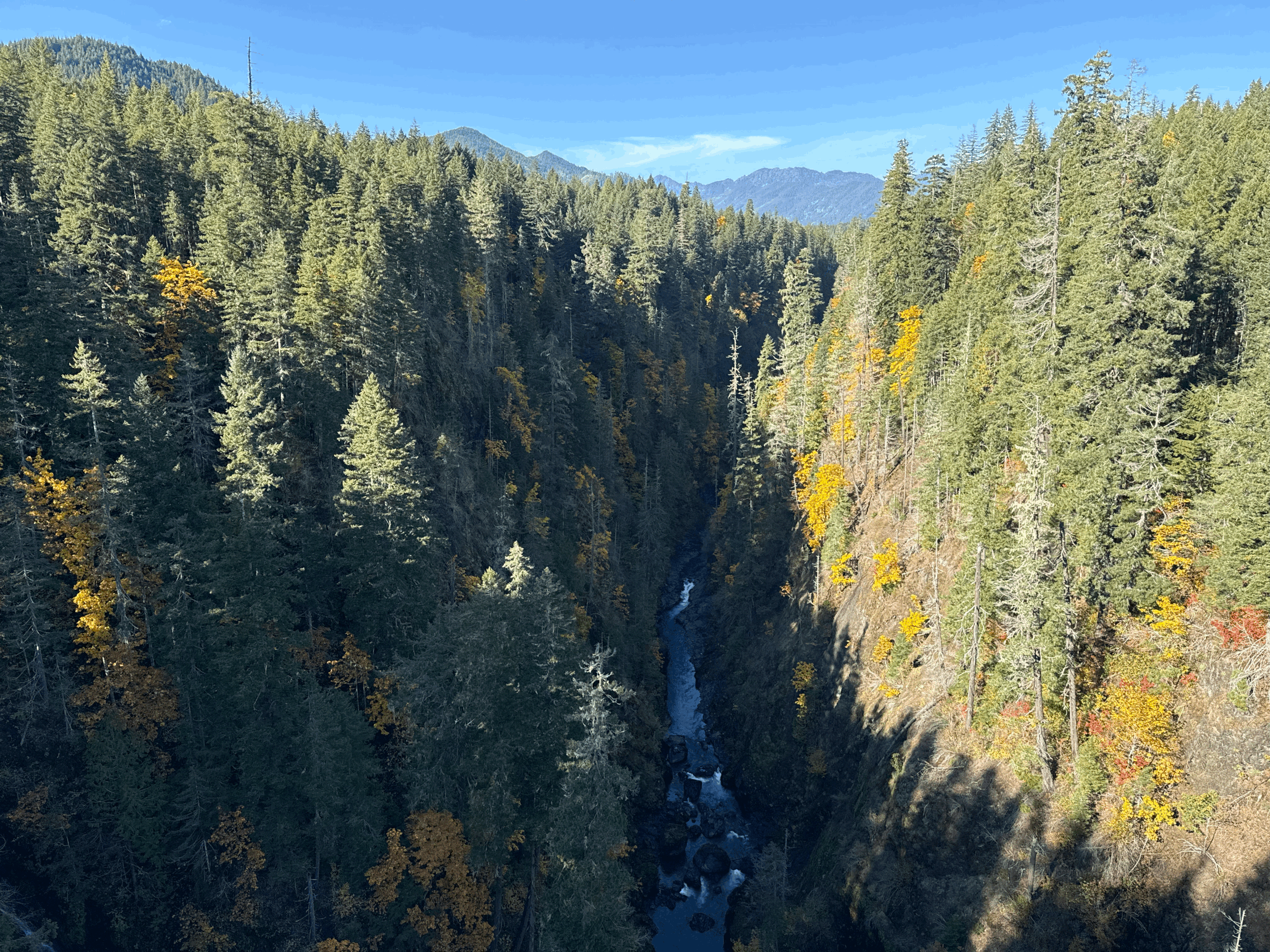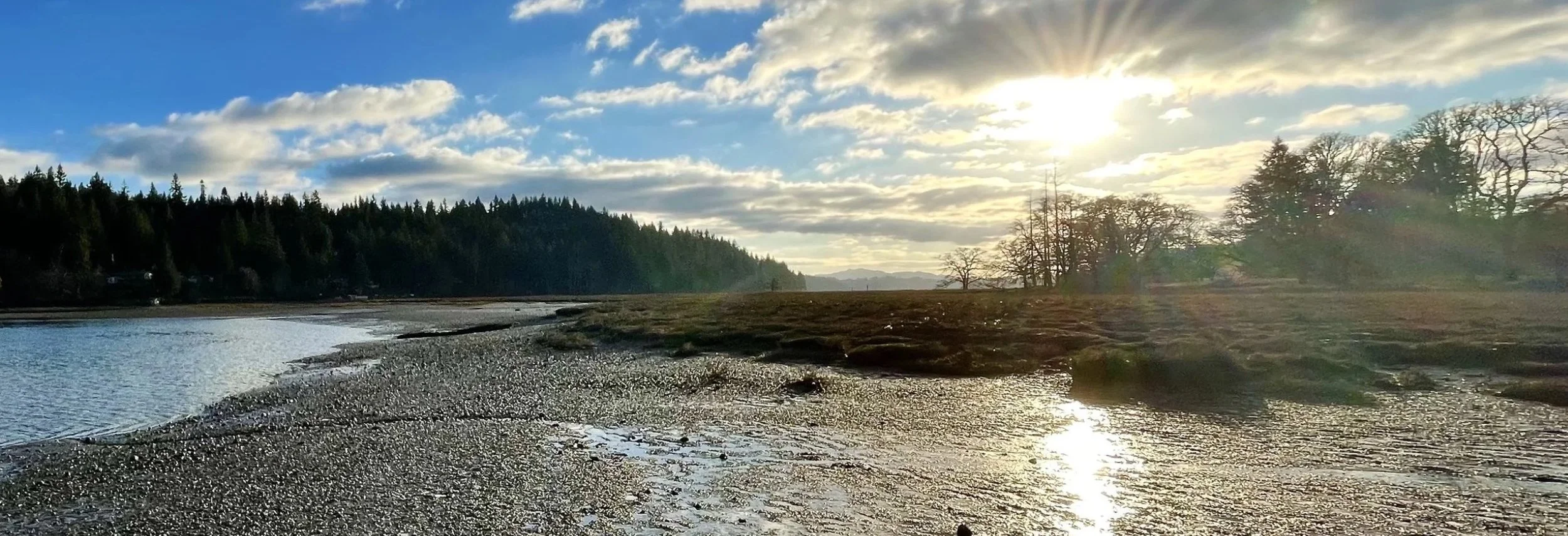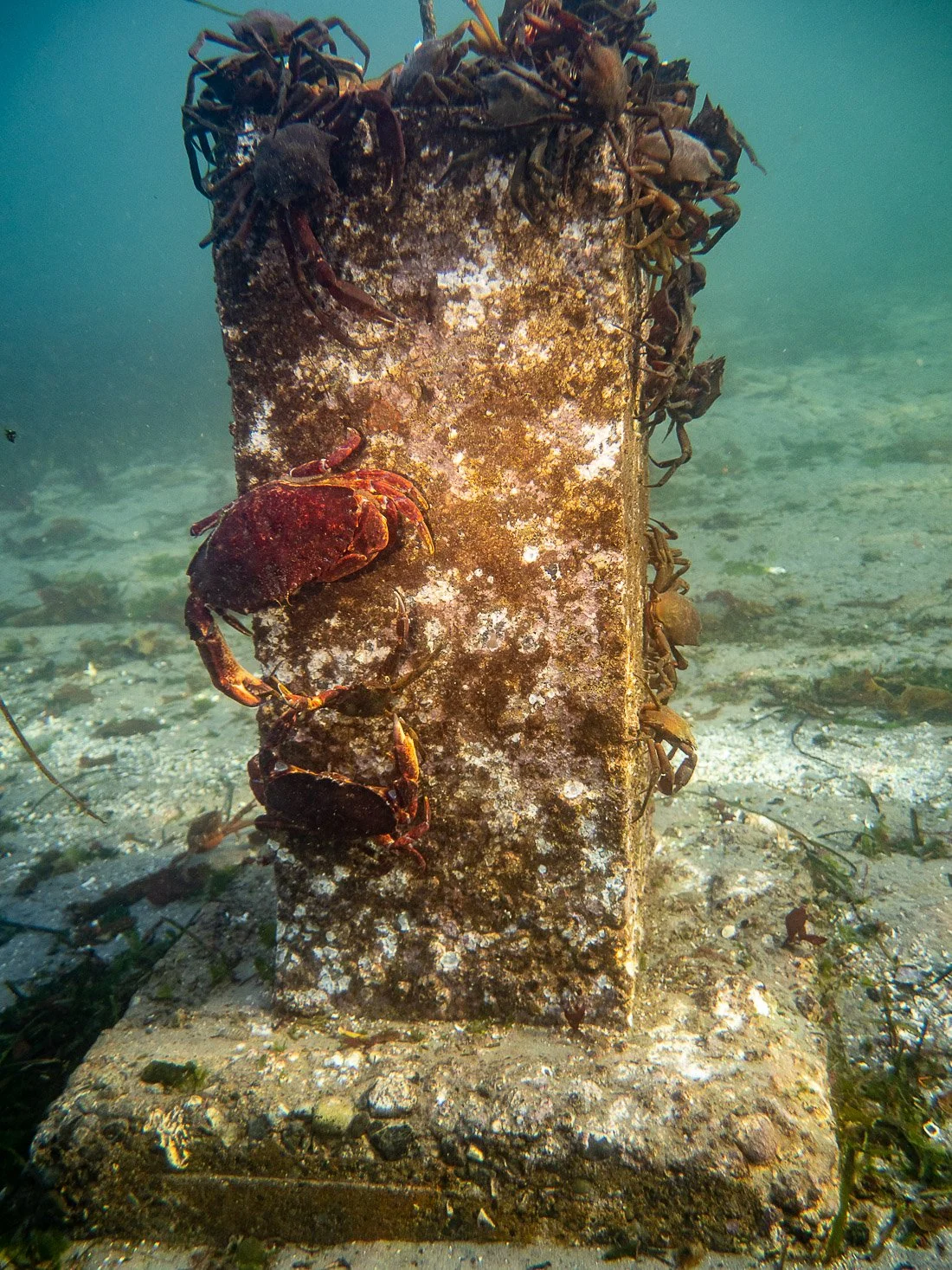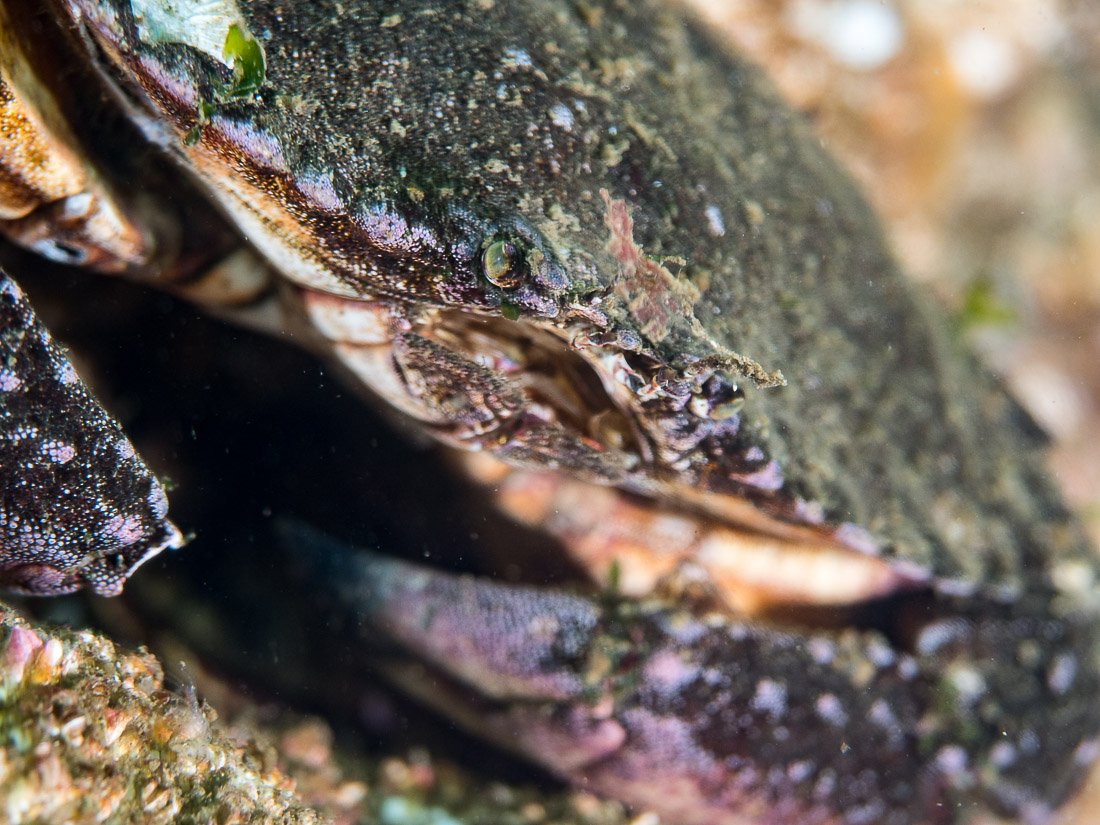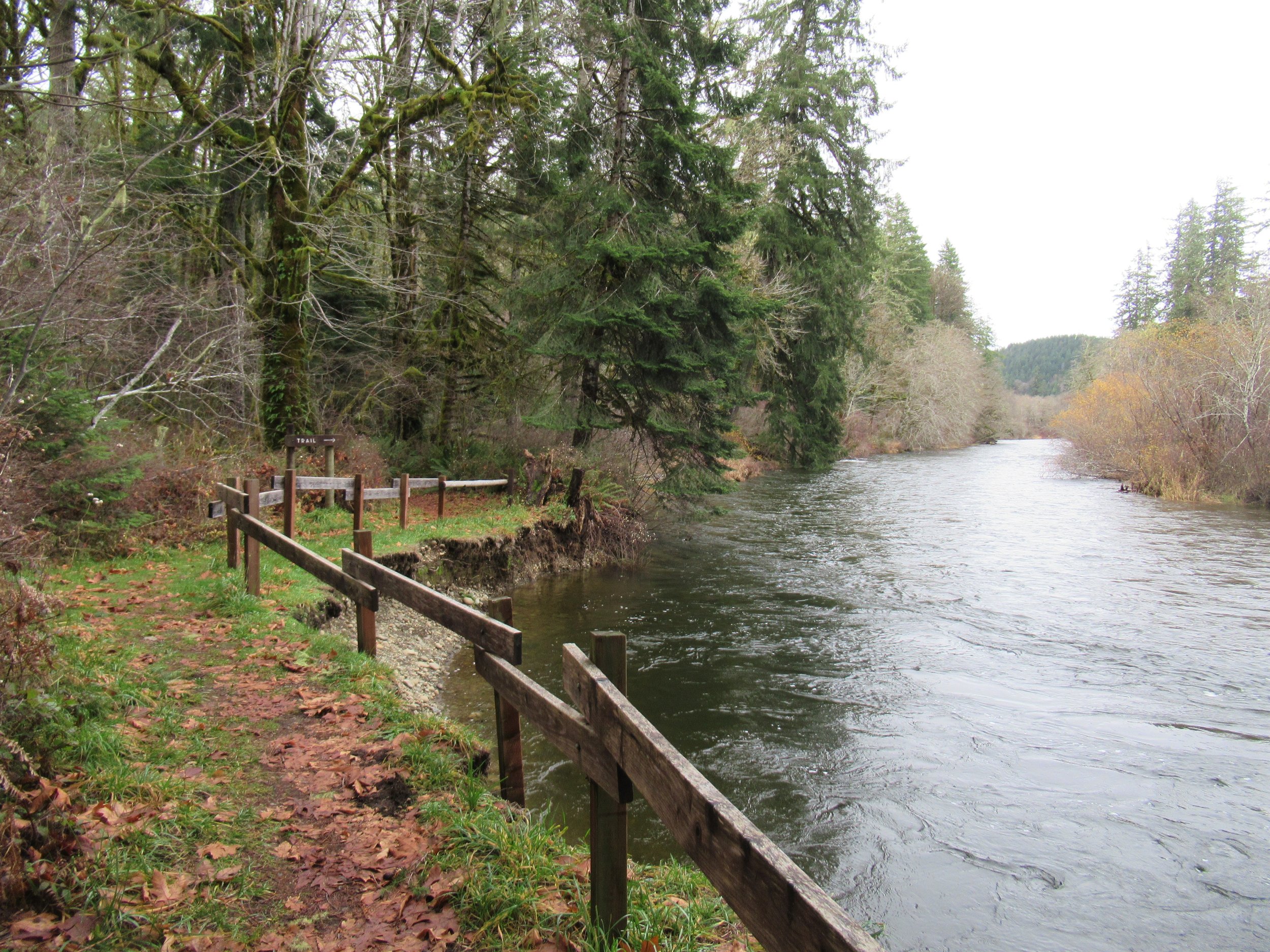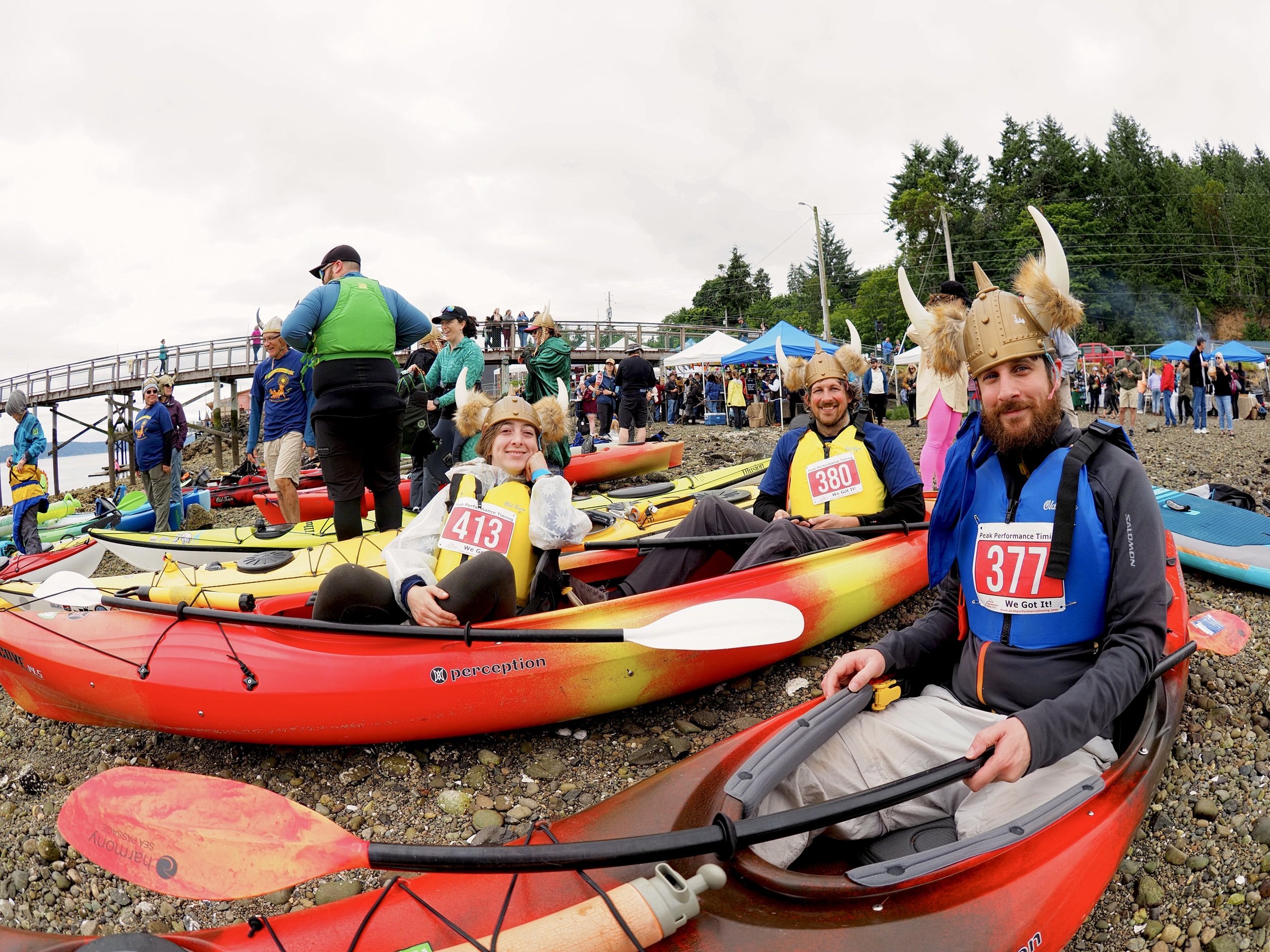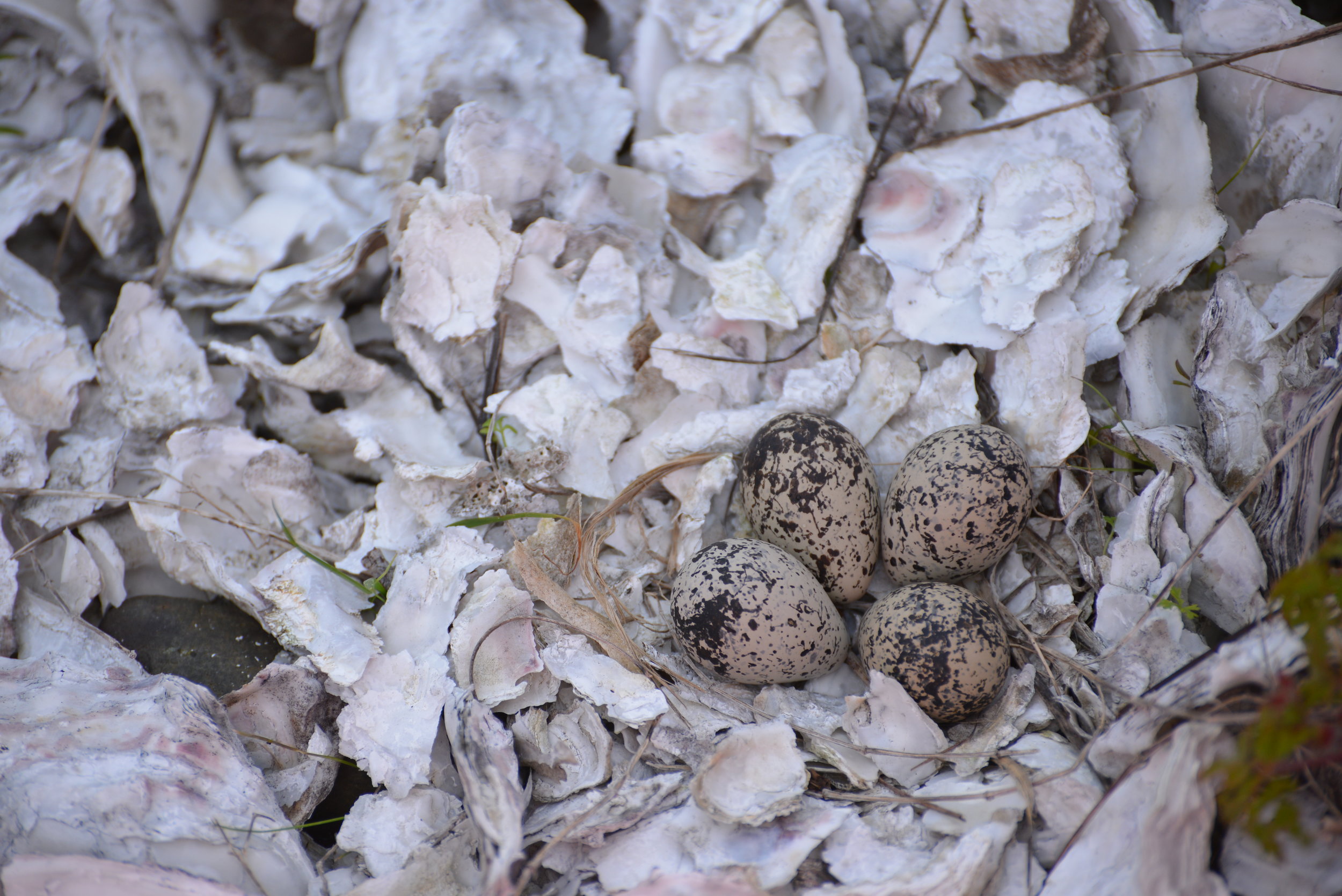
Operation Scrooge
This December, the historic Robin Hood Village Resort on Hood Canal will transform into a full-scale, multi-room production studio for one extraordinary purpose: bringing the magic of Christmas to local families in need. From noon on December 13 to noon on December 14, Operation Scrooge will host a 24-hour live-streamed music telethon, featuring 24 artists over 24 hours—a marathon of generosity, artistry, and community spirit.
This December, the historic Robin Hood Village Resort on Hood Canal will transform into a full-scale, multi-room production studio for one extraordinary purpose: bringing the magic of Christmas to local families in need. From noon on December 13 to noon on December 14, Operation Scrooge will host a 24-hour live-streamed music telethon, featuring 24 artists over 24 hours—a marathon of generosity, artistry, and community spirit.
Operation Scrooge began decades ago in a small Western New York town, where a compassionate teacher—Mr. Schuster—rallied his eighth-grade students to raise funds for families lacking the means to celebrate the holidays. One of those students remembers crossing snowy railroad tracks on Michigan Street to deliver gifts to neighborhood children he knew well. That experience stayed with him for life.Now living in Union, Washington, he and his wife have brought the tradition westward.
“When I discovered how much need exists within my own community, I knew it was time,” he shared. “Union is one of the greatest places on Earth—full of heart, full of music—and this is our chance to give back.”
In partnership with the beloved Hoodstock Music and Arts Festival, Operation Scrooge has secured the Robin Hood Village Resort for a full 24 hours of continuous entertainment. Local businesses, including Mosquito Fleet Winery, have joined in the effort—sponsoring a special “Paint and Sip” experience happening on-site during the telethon.
The live stream kicks off at noon on the 13th with fan favorites Honey Babe, and won’t sign off until Seth Ryan Unger wraps things up at noon on the 14th. Audiences can expect an eclectic lineup of musicians each donating their time and talent. Every hour brings a new act. Every act brings Operation Scrooge one step closer to helping local families experience the joy of the holiday season.
Honey Babe | Hoodstock 2025 photo
A Community Comes Together
Operation Scrooge is partnering with the Hood Canal School District to identify families facing the steepest challenges this year. More than 50 families are already hoping for assistance, and the goal is to help as many as possible. Every dollar raised stays right here on the canal, supporting local households with gifts, essentials, and a much-needed reminder that their community cares. The entire event will be streamed live on multiple platforms, welcoming viewers from around the world to enjoy the performances and contribute if they can.
The spirit of Mr. Schuster’s original project—neighbors helping neighbors—continues to burn bright, now illuminating the shores of Hood Canal .“Help us keep the tradition alive,” says Chris, “Let’s bring a smile, and the magic of Christmas, to those who need it most.”
Whether you donate, tune in, share the event, or simply help spread the word, your involvement makes a meaningful difference. Watch the livestream here:
Facebook: Operation Scrooge
youtube.com/ChrisEakesMusic
twitch.com/ChrisEakes
Hoodsport’s Yule Fest Celebration | DEC 13
Celebrate Hoodsport with caroling and events throughout town, December 13. Street booths begin to open around 3 PM and caroling begins at 530 PM.
Celebrate with Caroling, Crafts & Community! The Hoodsport business community is pleased to announce the third annual holiday downtown Hoodsport celebration – Yule Tide!
Families can enjoy activities, food and local shopping and festivities during the afternoon through early evening at businesses throughout town.
Look forward to caroling starting at the Christmas tree at Hoodsport Marina as at 5:30 PM. The carolers will stroll through Hoodsport with stops at businesses along the way.
Potlatch Brewery will once again host Santa Paws where you can get pictures with your pets and Santa Claus. They will also serve drinks and food available for purchase. The Hardware Distillery will be joined by The Tides on 101 Restaurant, serving up chowder for purchase. Canalside will be joined again by the Hood Canal Kiwanis Club for craft activity and pictures with Santa and Mrs. Claus and serving hot chocolate and cider. Local artists and craftspeople will be on site to provide guests with last minute gifts (starting around 1PM) and Canalside will be open late.
The Model T and other local businesses will join on the event with activities and warm treats for the traveling carolers as they traverse the route through town!
The caroling ends at Fjord Oyster Bank where there will be fire pits and free cocoa & marshmallow roasting. The Fjord will also host activities for families.
Parking is available along the street as well as at YSS Dive and Canalside parking lots, the Hoodsport Fish Hatchery and the Fjord Oyster Bank Restaurant.
For additional details on this events and others in the area including musical events and workshops, visit festivalofthefirs.com
A Guide to 25 Waterfalls from Canal to Coast and points between
Receiving hundreds of inches of rain annually, the Hoh, Quinault and Queets Rainforests are located on the coastal foothills of the Olympics, receiving 21+’ of snow and rain at its peaks! It’s no wonder there is a myriad of spectacular waterfalls lacing the area. Explore this sampling curated by celebrated guidebook author and avid hiker, Craig Romano. Some are small, secret, and unique, others are popular but magnificent. All are worth the journey!
When Craig Romano agreed to share with us a few of his favorite waterfalls in the Pacific Coastal region of Washington, we were frankly thrilled. If you’re looking for straight details on Northwest hikes and wilderness destinations — and fun facts - Craig is the guy to call.
Craig has written more than 20 hiking guidebooks including Day Hiking Olympic Peninsula 2nd Edition which includes details for popular and little known hikes across the Peninsula. An avid hiker, runner, paddler, and cyclist, Craig is currently working on Urban Trails Vancouver USA (2020); Backpacking Washington 2nd Edition (2021); and Day Hiking Central Cascades 2nd Edition (2022). He is also a featured columnist for the Fjord and Explore Hood Canal.
Enchanted Valley | Craig Romano photo
Why we are so keen about our falls?
As storms from the Pacific Ocean move across the peninsula, they crash into the Olympics and are forced to release moisture in the impact. Consequentially, the clouds release massive amounts of moisture (up to 170 inches annually) in the coastal side of the range – creating the “rain shadow effect.”
The massive rainfall has given life blood to the hanging mosses of the perpetually wet Northwest rainforests – Hoh and Quinault. On top the Olympic Mountains this moisture lands as snow frosting the peaks with as much as 35 feet each year.
Each spring the snow melts and creates icy run-off. Mix in a little more rainfall and the result is a spectacular waterfalls ring envelops the base of Olympic range.
Pacific coastal waterfalls are gorgeous year round but tend to be most spectacular in early spring or during the autumn rainy season.
Let’s go Chasing Waterfalls
1. Tumwater Falls
Olympia Metro | Located minutes from Olympia, Tumwater Falls is an iconic landmark near the state capital. These thundering multi-tiered showy falls along the Deschutes River are located within a 15-acre park created on land donated by the Olympia Brewing Company. Meander along manicured paths and saunter over foot bridges and under historic road bridges taking in a little history along with the sensational scenery.
At the base of the upper falls admire a replica of the famous bridge that once appeared on the labels of Olympia beer spanning the river above the lower falls. Walk trails along the gorge between the falls and admire deep pools, eddies and jumbled boulders. Take time to read the informative panels on Tumwater—Washington’s oldest permanent non-Native settlement on Puget Sound. Let’s Go!
2. Kennedy Creek Falls
Kamilche, South of Shelton | From its origin at Summit Lake in the Black Hills, Kennedy Creek flows just shy of 10 miles to Oyster Bay tumbling over a two-tiered waterfall along the way. Reaching these pretty falls involves a half day hike on a closed-to-vehicles logging road through patches of cuts and mature standing timber. Start walking across a recent cut. In about a mile reach a grove of mature timber and the Kennedy Creek Salmon Trail which opens in the fall for salmon viewing and field trips. Keep walking on the main road avoiding diverting roads. The route leaves state land for private timberland and rolls along. Take in decent views of the surrounding foothills. At 2.8 miles (just before crossing a creek) follow an obvious but unmarked trail to the right. This path can be muddy and slick during periods of heavy rainfall. The trail descends to a grove of big cedars, firs and yews—and the falls. Here Kennedy Creek tumbles over an ancient basalt flow. The upper falls are small but quite pretty. The lower falls are difficult to see as they tumble into a narrow chasm of columnar basalt. Let’s Go!
3. Vincent Creek Falls
South Hood Canal, Skokomish Valley | While Vincent Creek Falls are quite stunning crashing 250 feet into the South Fork Skokomish River in a deep narrow canyon; the High Steel Bridge which allows for their viewing is even more spectacular. The 685-foot long bridge spans 375 feet above the canyon. Walk across the bridge but use caution along its north side where the guardrail is only 3 feet tall. The arched truss steel bridge was built in 1929 originally for a logging railroad. In 1950 it was converted for road use. It is the 14th highest bridge in the country. Your heart is sure to pound as you walk upon its airy span. Eventually Vincent Creek Falls comes into view. Through a series of falls, Vincent Creek drops 250 feet down a canyon wall into the roaring South Fork Skokomish River. Walk all the way across the bridge if you plan on capturing the falls in their entirety in a photo. Let’s Go!
Big Creek | Craig Romano Photo
4. Big Creek Cascades
Lake Cushman Area, Hood Canal | Amble on a circuitous route in the Big Creek drainage within the shadows of Mount Ellinor; and delight in a series of small tumbling cascades. This wonderful loop utilizes old logging roads, new trails and a series of beautifully built bridges. It was constructed by an all-volunteer crew that continues to improve and maintain this excellent family and dog-friendly loop. Starting from the Big Creek Campground, follow the Upper Big Creek Loop Trail to Big Creek and the first of several sturdy bridges along the way. After a short climb you’ll reach the Creek Confluence Trail which drops to the confluence of the tumbling Big and North Branch Creeks. The main loop continues to cross North Branch Creek on a good bridge. Just beyond it crosses Big Creek on a new bridge above a gorgeous cascade. The loop then descends skirting big boulders and passing good views of roaring Big Creek. It crosses a couple more cascading creeks before traversing attractive forest and returning to the campground. Let’s Go!
5. Staircase Rapids
Lake Cushman Area, Hood Canal — Currently Closed until mid-September
This loop involves a section of an historic route across the Olympic Mountains to a suspension bridge spanning the North Fork Skokomish River near a series of thundering rapids. Cross the North Fork Skokomish on a solid bridge and follow a trail that was once part of the original O’Neil Mule Trail. In 1890 Lieutenant Joseph O’Neil accompanied by a group of scientists led an Army expedition across the Olympic Peninsula. Among his party’s many findings was a realization that this wild area deserved to be protected as a national park. March up alongside the roiling river, passing big boulders and a series of roaring rapids. The rapids’ name come from a cedar staircase O’Neil built over a rocky bluff to get past them. Follow the bellowing river from one mesmerizing spot to another before reaching a sturdy suspension bridge spanning the wild waterway. Cross the river and complete this delightful loop by now heading downriver following the North Fork Skokomish River Trail back to the Ranger Station. Let’s Go!
Hamma Hamma | George Stenberg photo
6. Hamma Hamma Falls
Hamma Hamma River Valley, Hood Canal | Talk about a bridge over troubled waters. From the Mildred Lakes Trailhead walk across the high concrete bridge at the road’s end. You no doubt heard the roar of the falls when you drove across it. Now peer over the bridge and witness the cataracts responsible for the racket.
Directly below, the Hamma Hamma River careens through a tight rocky chasm. These impressive falls are two-tiered crashing more than 80 vertical feet. The road spans directly above the upper and smaller of the falls. The overhead view is pretty decent, but the lower and larger falls are more difficult to fully see. A very rudimentary path leads along cliff edges for better viewing, but it’s slick, exposed and treacherous.It’s best to experience the falls from the safety of the bridge. During periods of high water flow you’ll get the added bonus of feeling the falls too thanks to a rising mist. On the drive back look for a couple of pull-offs providing views of secondary falls along the Hamma Hamma, Let’s Go!
7. Murhut Falls
Duckabush River Valley, Hood Canal | Hidden in a lush narrow ravine and once accessed by a treacherous path, Murhut Falls were long unknown to many in the outside world. But now a well-built trail allows hikers of all ages and abilities to admire this beautiful 130-foot two-tiered waterfall. The trail starts by following an old well-graded logging road. It was past logging in this area that led to the discovery of these falls. The old road ends after a short climb of about 250 feet to a low ridge. The trail then continues on a good single track slightly descending into a damp, dark, cedar-lined ravine. As you work your way toward the falls, its roar will signal you’re getting closer. Reach the trail’s end and behold the impressive falls crashing before you. The upper falls drops more than 100 feet while the lower one crashes about 30 feet. Blossoming Pacific rhododendrons lining the trail in May and June make the hike even more delightful. Let’s Go!
Rocky Brook Falls
8. Rocky Brook Falls
Dosewallips River Valley, Hood Canal | One of the tallest waterfalls on the Peninsula, Rocky Brook Falls is also among the prettiest. Follow the trail past a small hydroelectric generating building and come to the base of the stunning towering falls fanning over ledges into a large splash pool surrounded by boulders. This classic horsetail waterfall crashes more than 200 feet from a small hanging valley above. While a penstock diverts water from the brook for electricity production, the flow over the falls is almost always pretty strong. Like all waterfalls, these too are especially impressive during periods of heavy rainfall. On warm summer days the falls become a popular destination for folks seeking some heat relief. And while many waterways east of the Mississippi River are called brooks, creek is the preferred name in the west. There are only a few waterways on the Peninsula called brooks, and they were more than likely named by someone who hailed from back east. Let’s Go!
9. Dosewallips Falls
Dosewallips River Valley, Hood Canal | This spectacular waterfall used to be easily reached by vehicle. But the upper Dosewallips Road has been closed to vehicles since 2002 after winter storms created a huge washout that has yet to be repaired. Now to reach this waterfall you must hike or mountain bike the closed road. Walk past the road barrier and immediately come to the washout and a bypass trail. Steeply climb on the riverbank above the slide. Then descend back to the road and walk along the churning river. The road then pulls away from the river, passes a campground and climbs. The river now far below in a canyon is out of sight, but not out of sound. Pass beneath ledges and cross cascading Bull Elk Creek on a bridge. At 3.9 miles in a recent burn zone enter Olympic National Park. Cross tumbling Constance Creek on a bridge and continue climbing passing a big overhanging boulder. Then descend and skirt beneath a big ledge coming to the base of dramatic 100-foot plus Dosewallips Falls. Admire the raging cascade’s hydrological force—it’s mesmerizing. Let’s Go!
10. Fallsview Falls
Big Quilcene River Valley | As far as cascades go, Fallsview Falls lacks the “Wow factor.” However the canyon these falls tumble into is pretty impressive. And if you plan your visit for late spring, blossoming rhododendrons line the trail and frame the view with brilliant pinks and purples. The trail to the falls is short, easy and ADA accessible. Follow the 0.2 mile loop to a fenced promontory above a tight canyon embracing the Big Quilcene River. Gaze straight down to the roiling river. Then cast your glance directly across the canyon to an unnamed creek cascading 100 feet into it. By late summer it just trickles—but during the rainy season the falls put on a little show. If you want to stretch your legs some more afterward, you can follow a trail into the little canyon and hike along the frothing river. Let’s Go!
And 15 more…
For a day trip, weekend, or a month-long adventure – the Olympic Peninsula is a fantastic place to get away and enjoy nature – and waterfalls! It’s not just 1000’s of waterfalls, there are countless lakes, rivers, streams and trails to suit every ability level. Embraced by the Pacific Ocean on the west, the Strait of Juan de Fuca on the north, and the Hood Canal on the east, it is famed for being home to Olympic National Park, more than 600 miles of hiking trails and 73 miles of pristine ocean wilderness beaches.
The Olympic Peninsula hosts activities for families and outdoor enthusiasts alike, attracting visitors from near and far. Start planning your next adventure!
Click here for a complete list of all 25 waterfalls on the Olympic Peninsula curated by Craig!
Holiday Magic in Shelton | DEC 5-6
Despite the rain and sleet, the holiday spirit is alive and well this week in Shelton as volunteers deck the downtown streets and prepare for the big Christmastown seasonal kick-off, Holiday Magic, December 5-6.
Christmatown is alive with holiday magic
If you don’t like Hallmark movies, stay away from Shelton, next weekend as the holiday spirit is alive and well here this week as volunteers deck the downtown streets and prepare for the big seasonal kick-off, Holiday Magic, December 6-7.
The festivities start Friday with the opening of the 2025 Guinness Ttribute Christmastown Maze and Camp Grisdale on Cota Street next to the Shelton Civic Center. For the 6th year in a row, the maze has welcomed families to enjoy a festive FREE activity with the support of local non-profits that host cocoa and marshmallow roasting pits each evening.
Friday, DEC 5 starting at 4 PM, head over to the maze or some fun FREE activities at KMAS Radio and the Morning Show Host, Jeff Slakey, host the a Community Christmas Party with crafting, music, wreath workshops, food, and a selection of local vendors.
Interested in building a cookie palace? Be sure to get your gingerbread entries into the Shelton Mason County Chamber office by 5PM, Friday!
At 6 PM Friday the crowds will be gathering in Post Office Park for the return of the Shelton tree lighting hosted by the Kristmas Town Kiwanis and Shelton Downtown Merchants. Enjoy choirs of school children singing carols and free hot chocolate and cookies sponsored by 2nd Street Design.
The street party continues on Railroad Avenue with fire pits in the street to roast marshmallows and kiddie train rides as well as evening shopping (until 8) at downtown merchants. Be sure to pick up a Shop Local First rewards card and uses it at participating merchants to win great prizes.
Santa Claus Parade Saturday
At 5 PM Saturday Kristmas Town Kiwanis and the Shelton Downtown Merchants clear the streets for the Christmas Parade. Peninsula Credit Union will be hosting free hot chocolate.
Another spot to tie the knot
Planning a wedding? It’s never too soon to be scoping out locations! Hood Canal’s Mike’s Beach Resort is embracing a new chapter, with the opening of the brand-new Salish Hall, a stunning indoor event space on the waterfront, the resort now offers couples more opportunities to celebrate a local destination wedding surrounded by breathtaking views and timeless beauty.
For generations, Mike’s Beach Resort has been a beloved Pacific Northwest getaway — a place where families return year after year to relax, reconnect, and take in the stunning natural beauty of the Hood Canal. Nestled between the majestic Olympic Mountains and the calm, shimmering waters of the canal, this historic resort offers an authentic slice of coastal Washington charm. From its classic waterfront cabins to cozy family rooms and glamping tents, Mike’s has always been about creating lasting memories in the heart of nature.
Now, as the resort continues its legacy, the classic lodging staple is embracing a new chapter — becoming one of the region’s waterside wedding and event destinations. With the opening of the brand-new Salish Hall, a stunning indoor event space on the waterfront, the resort now offers couples the opportunity to celebrate their love surrounded by breathtaking views and timeless beauty.
Introducing Pine and Tide Events
Welcome to Pine and Tide Events, where the natural beauty of the Pacific Northwest meets thoughtful design. Operating at both Mike’s Beach Resort and Iliana’s Glamping Village, Pine and Tide provides a range of unique venues and accommodations perfect for all inclusive weekend wedding celebrations - including a range of outdoor activities in the woods and on the water.. Whether it’s an elegant waterfront ceremony at Mike’s or a woodland vow exchange at Iliana’s Glamping Village, the updated venue offers a flexible canvas for your dream wedding. Celebrate surrounded by the scent of cedar and salt air, and let nature be your backdrop.
The Venues
Mike’s Beach Resort
Up to 68 overnight guests
Waterfront ceremony and reception space
Brand-new Salish Hall for indoor celebrations
Bridal prep suite and groom’s flex room
Pet-friendly accommodations
Waterfront cabins, family rooms, and cozy motel rooms
Iliana’s Glamping Village
Up to 28 overnight guests
Woodland ceremony space beside a tranquil stream
Lawn reception area and Wildwood Wedding Bar
Rustic-luxury glamping tents with modern comforts
Together, these venues offer the perfect blend of comfort, adventure, and natural beauty, making them ideal for couples seeking a relaxed, immersive wedding experience that extends beyond a single day.
We especially love that they have a wedding venue supply “closet!” WOW — what a fun Pinterest moment!
Beyond the celebrations, Mike’s invites guests to experience the simple joys of coastal exploring — from gathering around open-air fire pits and BBQs on the waterfront, to harvesting your own oysters and clams at the resort’s private U-Pick shellfish beach. And with Olympic National Park and a host of hikes are just a short drive away, adventure is always within reach. Slow down, reconnect, and celebrate life’s most meaningful occasions surrounded by the natural splendor of the Pacific Northwest.
Following fall around the Fjord
Autumn is one of the most stunning times to explore Mason County. With crisp air, golden leaves, and peaceful waterways, every turn offers a postcard-worthy view. Whether you’re a local looking for a weekend adventure or a visitor planning a scenic day trip, Mason County’s natural beauty truly shines this time of year.
Jeff Slakey | EHC contributor
This past week, I spent the day traveling around Mason County, capturing some of the incredible fall colors, and it couldn’t have been a better day for it.
I started at a foggy Lake Isabella State Park before heading into Shelton to see the waterfall at the Teresa Johnson Trail. Along the way a great spot to pause and admire the view at Outlook Park just south of Shelton. Along with fantastic views of the Olympics and the fall colors over the terminus of Hammersly Inlet, you’ll be able to check out the 32’ oysterman mural posted for October’s OysterFest event. Soon he’ll be changed out for the iconic Santa Claus reproduction from 1965 — heralding yet another change of the season. From there I headed down through the impressive leafy tunnel descending into Shelton. A quick pitstop on Cota Street to grab a coffee at Marmos, then a right, following Highway 3 past the Oakland Bay Marina, where a few seals were playing near the docks. After that, I cranked up KMAS and hit the road again with stops at Oakland Bay Preserve to check out the salmon runs.
Back in the car I headed back to Hwy 101 and north to Potlatch State Park where you get a great vantage of the colors on the far banks of the Canal. This is a great spot to pause. Trees laden with apples and tons of wildlife. I spotted a heron patiently hunting for lunch, perched on a buoy.
As the afternoon progressed and the sun started shining, I left Potlatch to see what the salmon were doing near the Hoodsport Hatchery. They were making their way up Finch Creek, dodging fishermen casting lines nearby. Before my camera batteries died, I was heading back south toward Shelton. I took the Skokomish Valley Road and headed up to the High Steel Bridge. By then, the fog had lifted, and the views of the canyon were as clear and bright as the fall leaves.
You don’t have to hit all those spots in one day like I did. In fact, when the weather’s nice (and there are still plenty of nice days left!), stop at just one or two to really soak in the beauty of Mason County this time of year. Or maybe keep following the curves of the Canal and make your destination Hama Hama Oysters at Lilliwaup. Every bend is worth whipping out the good lens.
Happy exploring.
Spider Lake: Perfect year round hiking destination
With a name that may instill a chill if you’re prone to arachnophobia, fear not a visit to Spider Lake. Children will love hiking along its shores looking for birds, fish, amphibians and other critters. They’ll also appreciate the well-built bridges spanning the lake’s inlet and outlet streams. And the trail with its gentle course around the lake is ideal for hikers of all ages and abilities.
With a name that may instill a chill if you’re prone to arachnophobia, fear not a visit to Spider Lake. The small lake on the South Fork Skokomish River—Satsop River divide is actually an inviting place. Surrounded by towering ancient conifers and fed by cascading creeks, Spider Lake is quite tranquil. Children will love hiking along its shores looking for birds, fish, amphibians and other critters. They’ll also appreciate the well-built bridges spanning the lake’s inlet and outlet streams. And the trail with its gentle course around the lake is ideal for hikers of all ages and abilities.
Hit the Trail
Hikers of a certain age may start humming the Jim Stafford classic Spiders and Snakes upon beginning their jaunt to this lake. And if you’re in agreement to the chorus of “I don’t like spiders and snakes…” take solace. There are only three species of snakes that call the Olympic Peninsula home, and none of them are venomous. However there are more than 900 species of spiders that reside on the peninsula! Yet, the majority of them you’ll never encounter. And the common ones, crab spiders, jumping spiders, and orbweavers are nothing to be afraid of. You’re more likely to run into their webs (especially if you’re the first one on the trail that day) than into them. Voracious eaters of insects, spiders help keep the population of those hiking nuisances down.
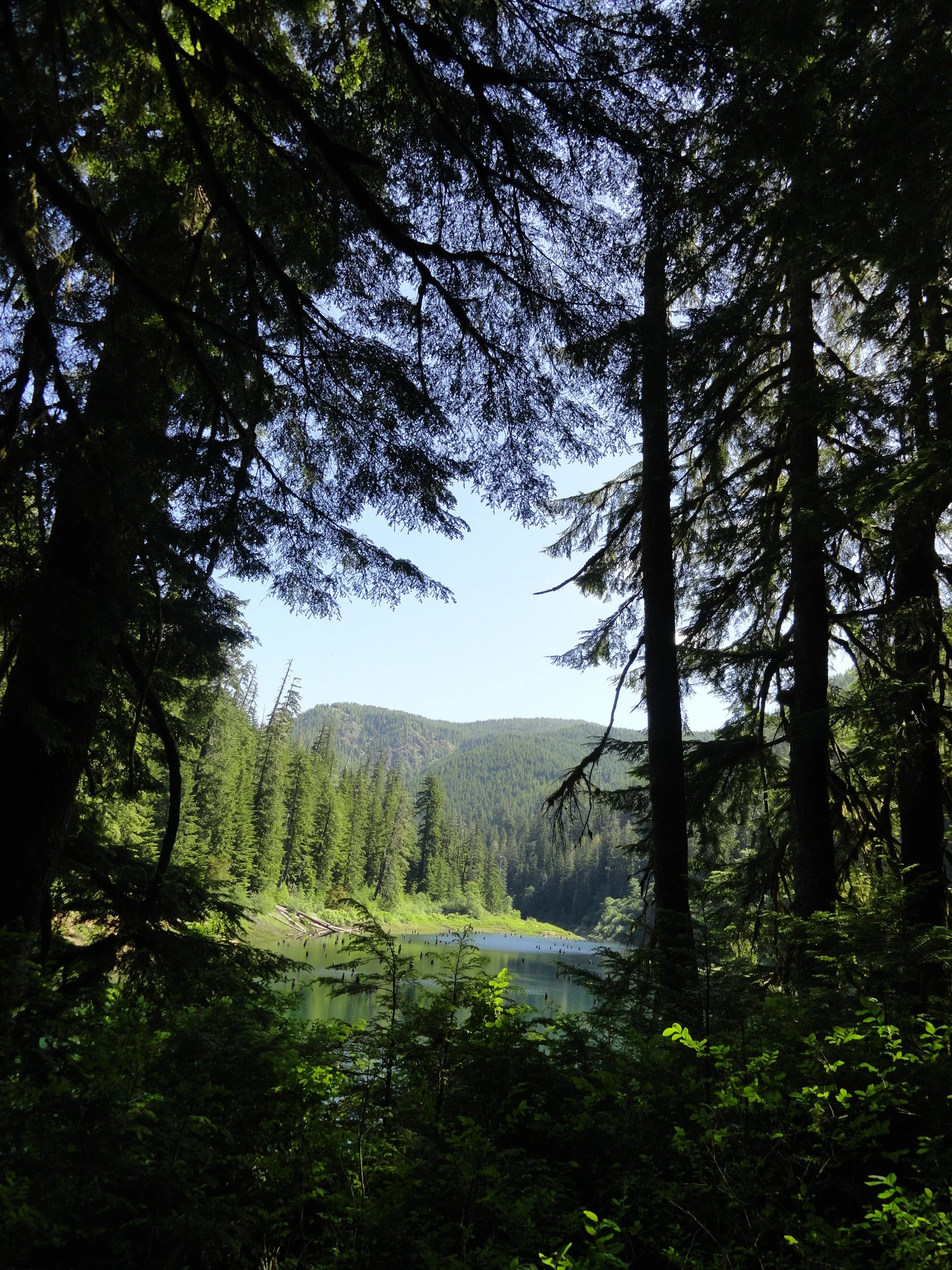
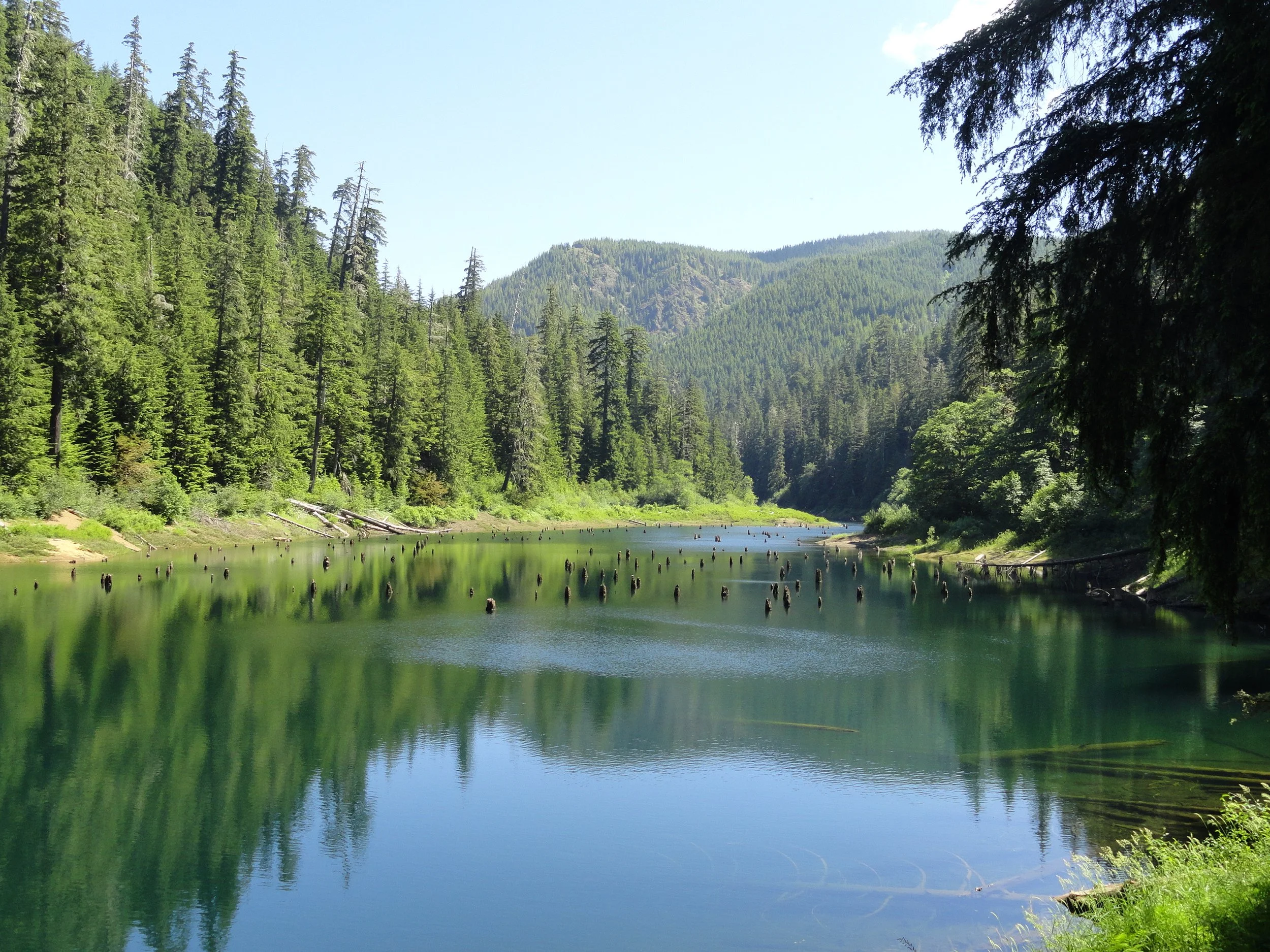

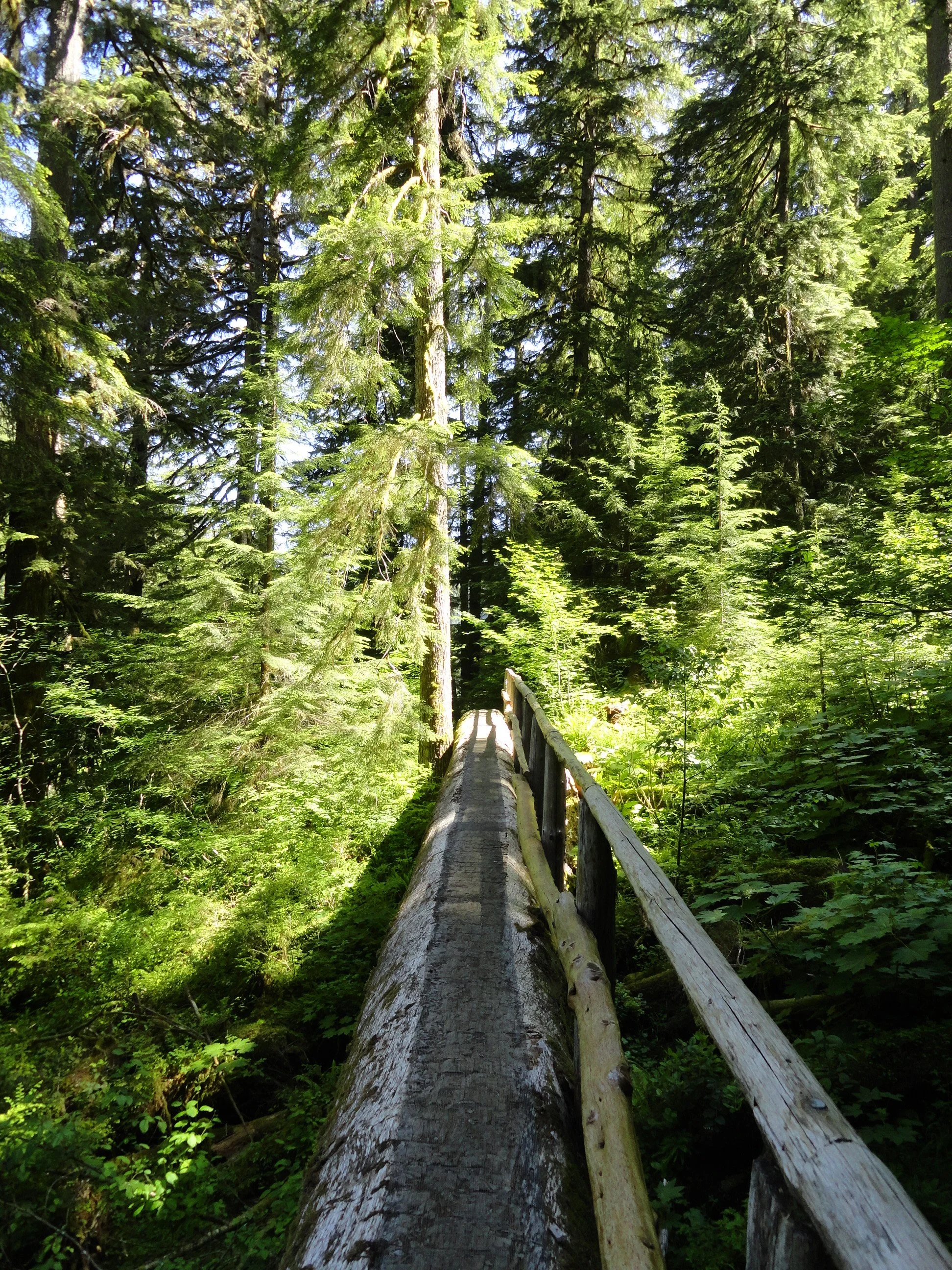
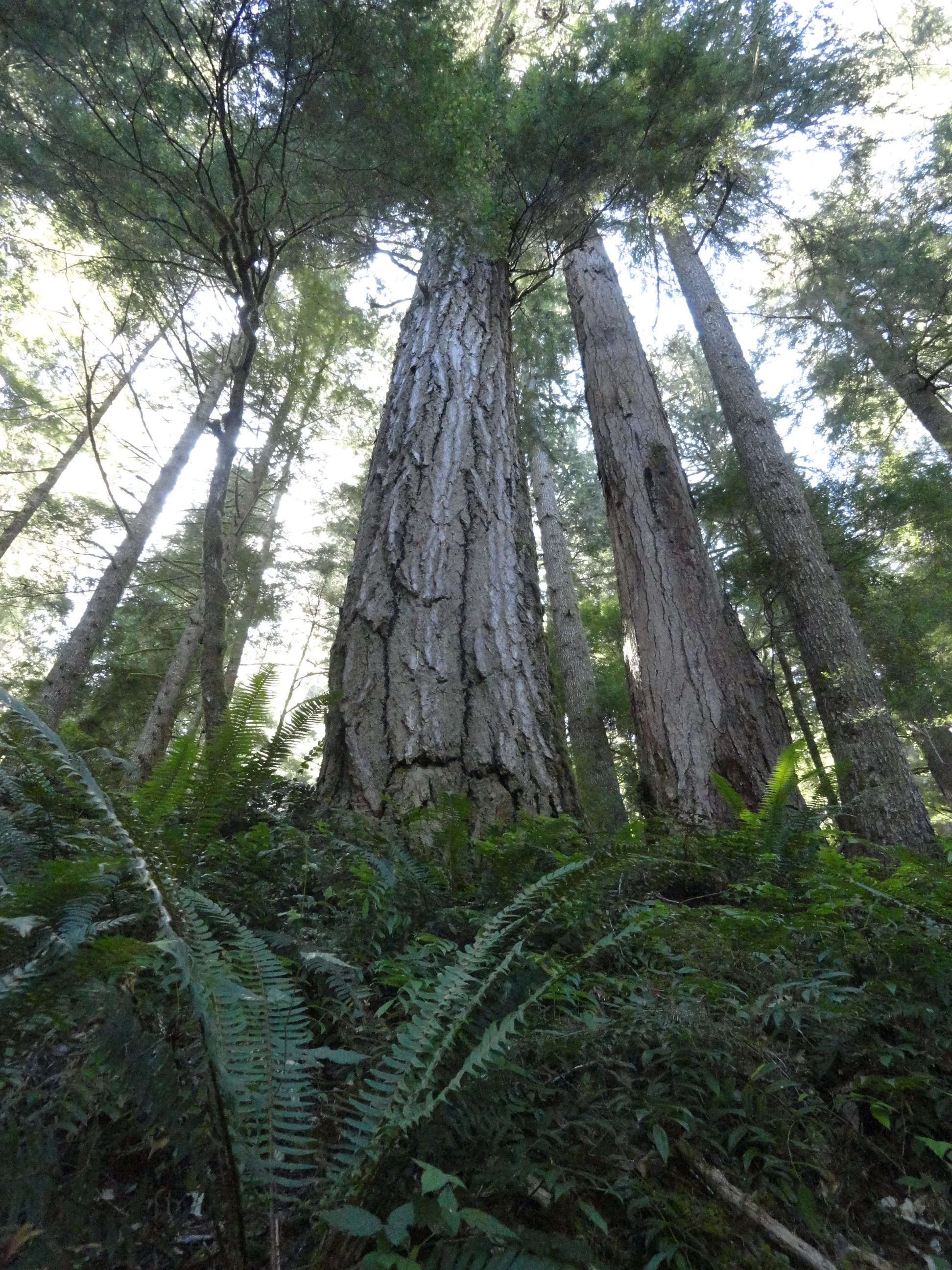

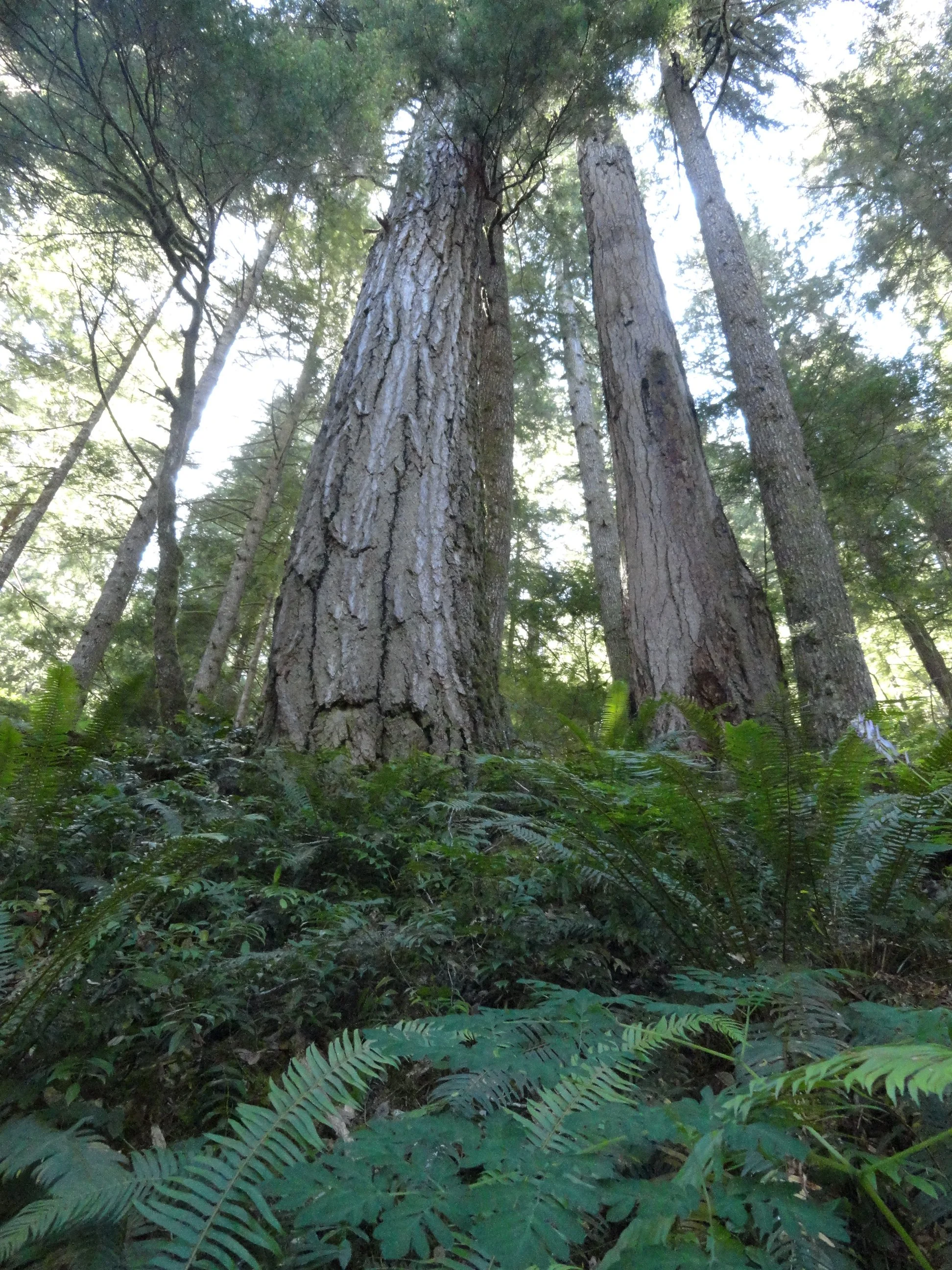


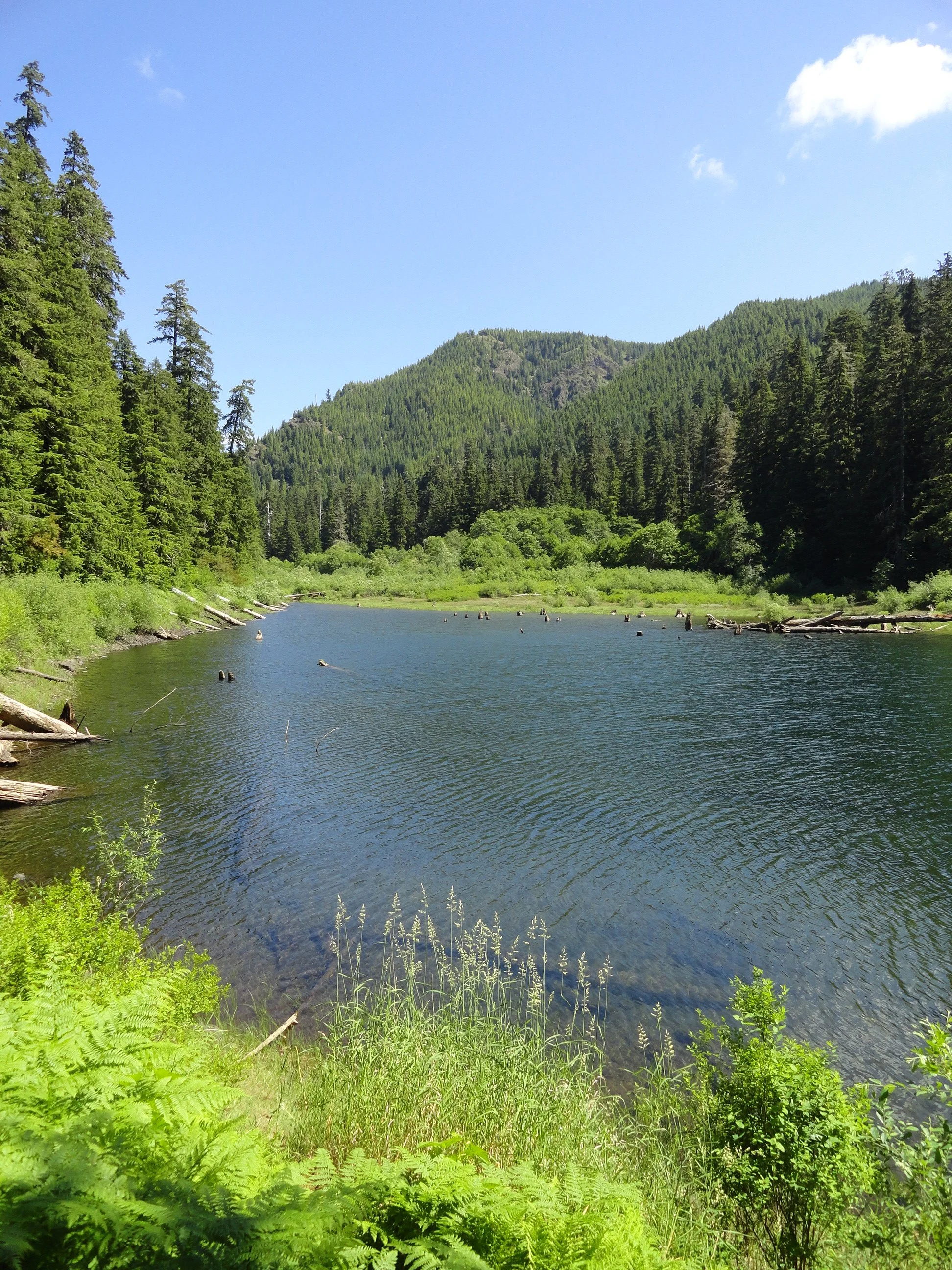

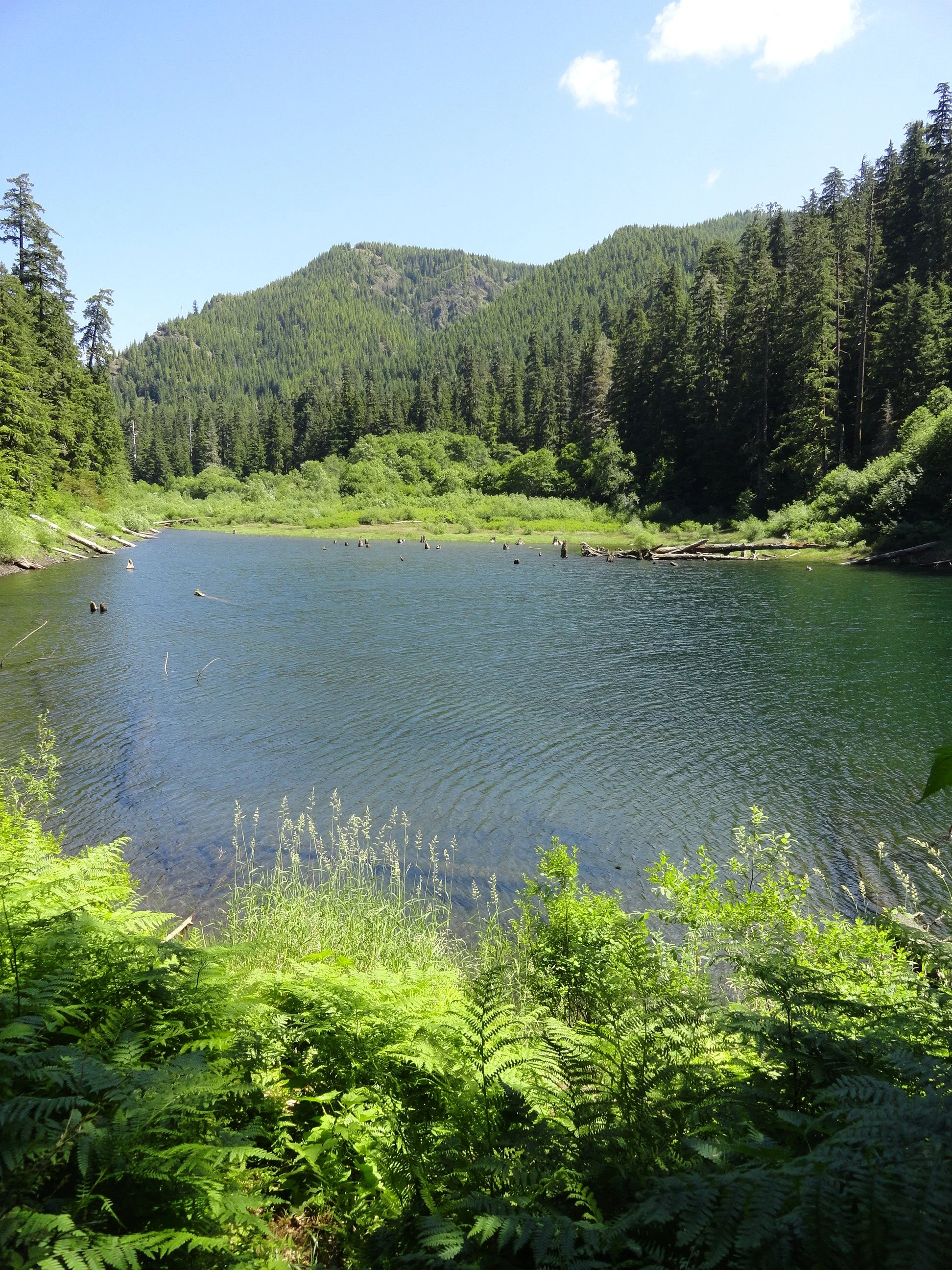
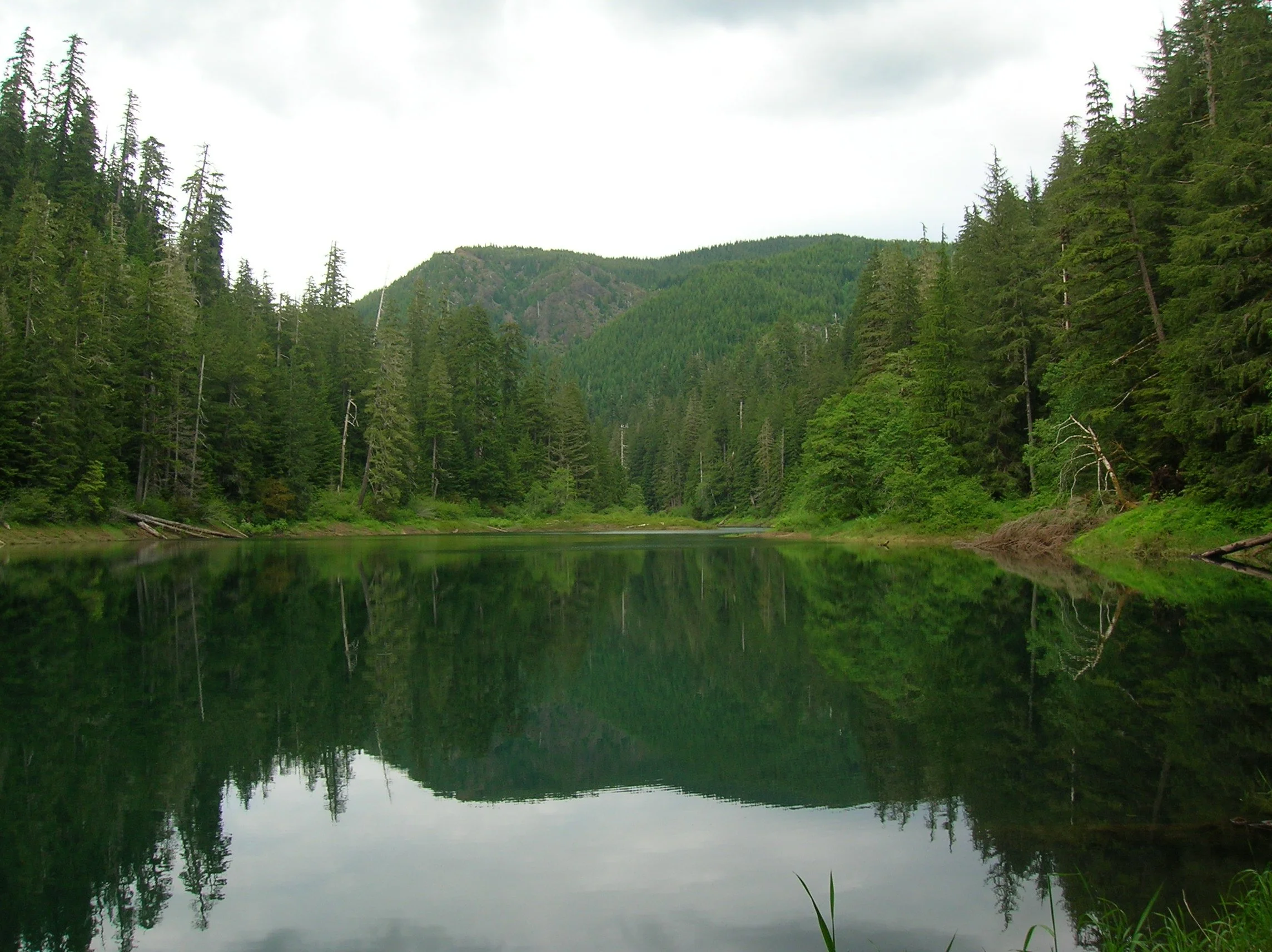
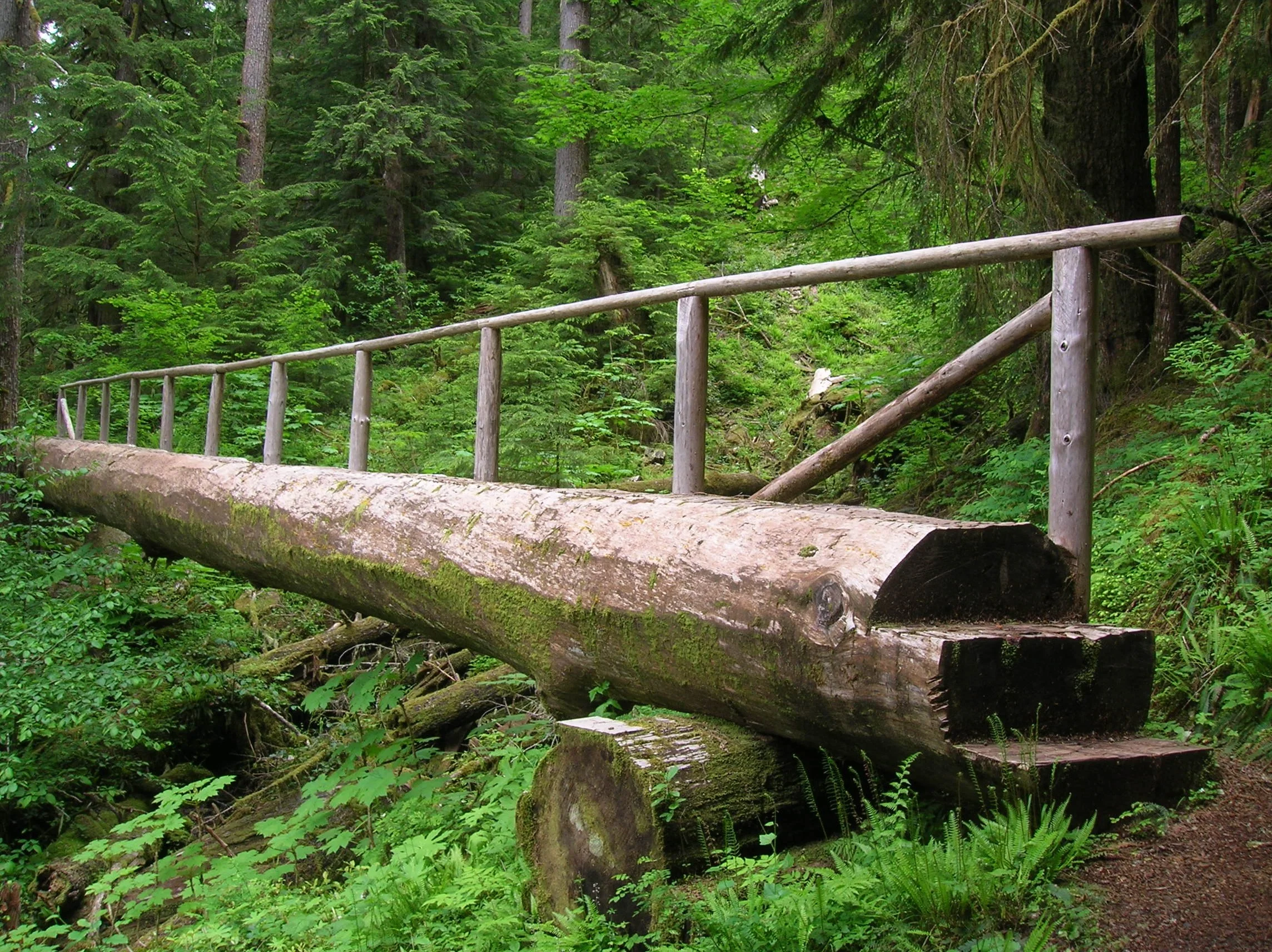
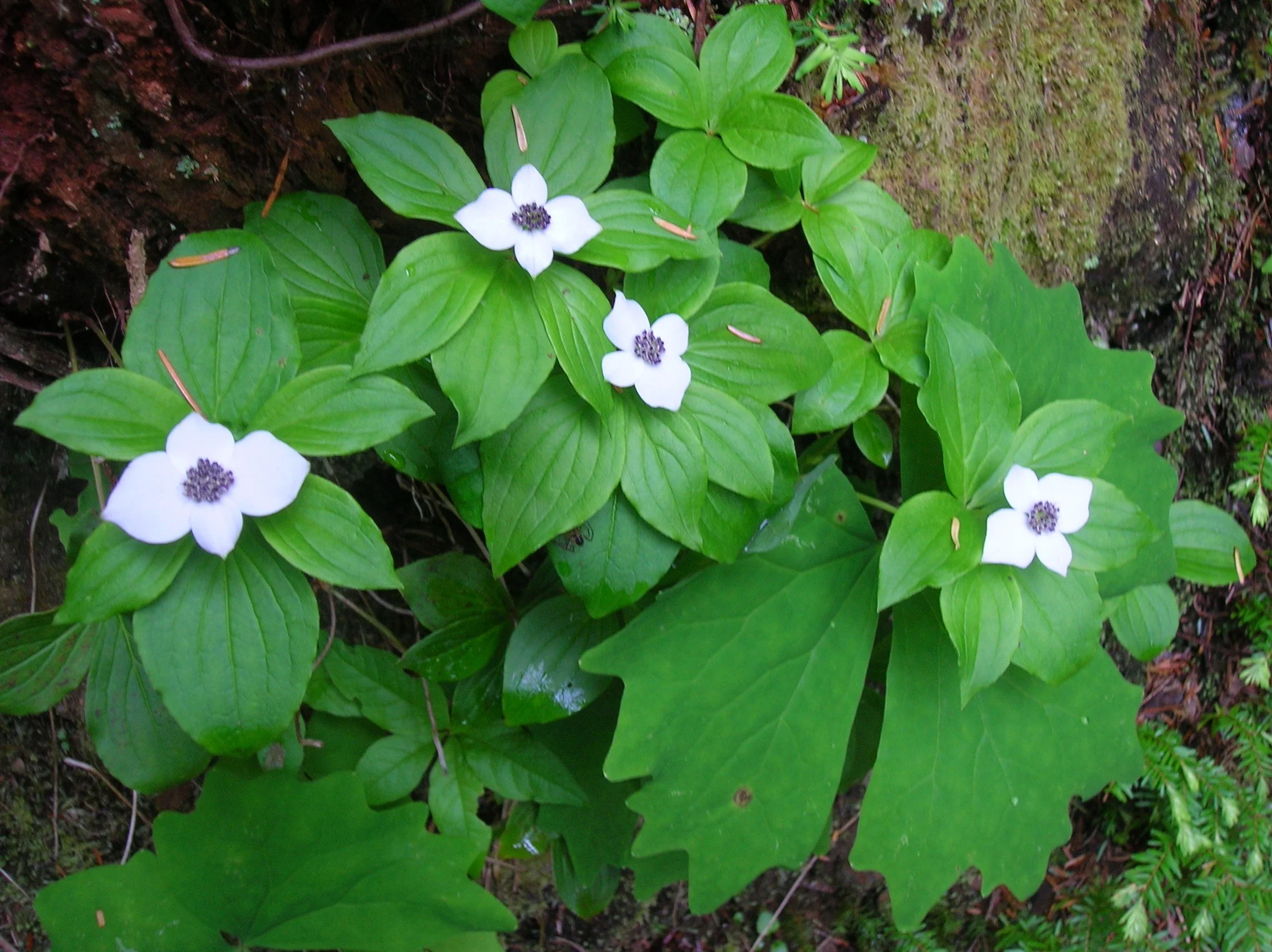
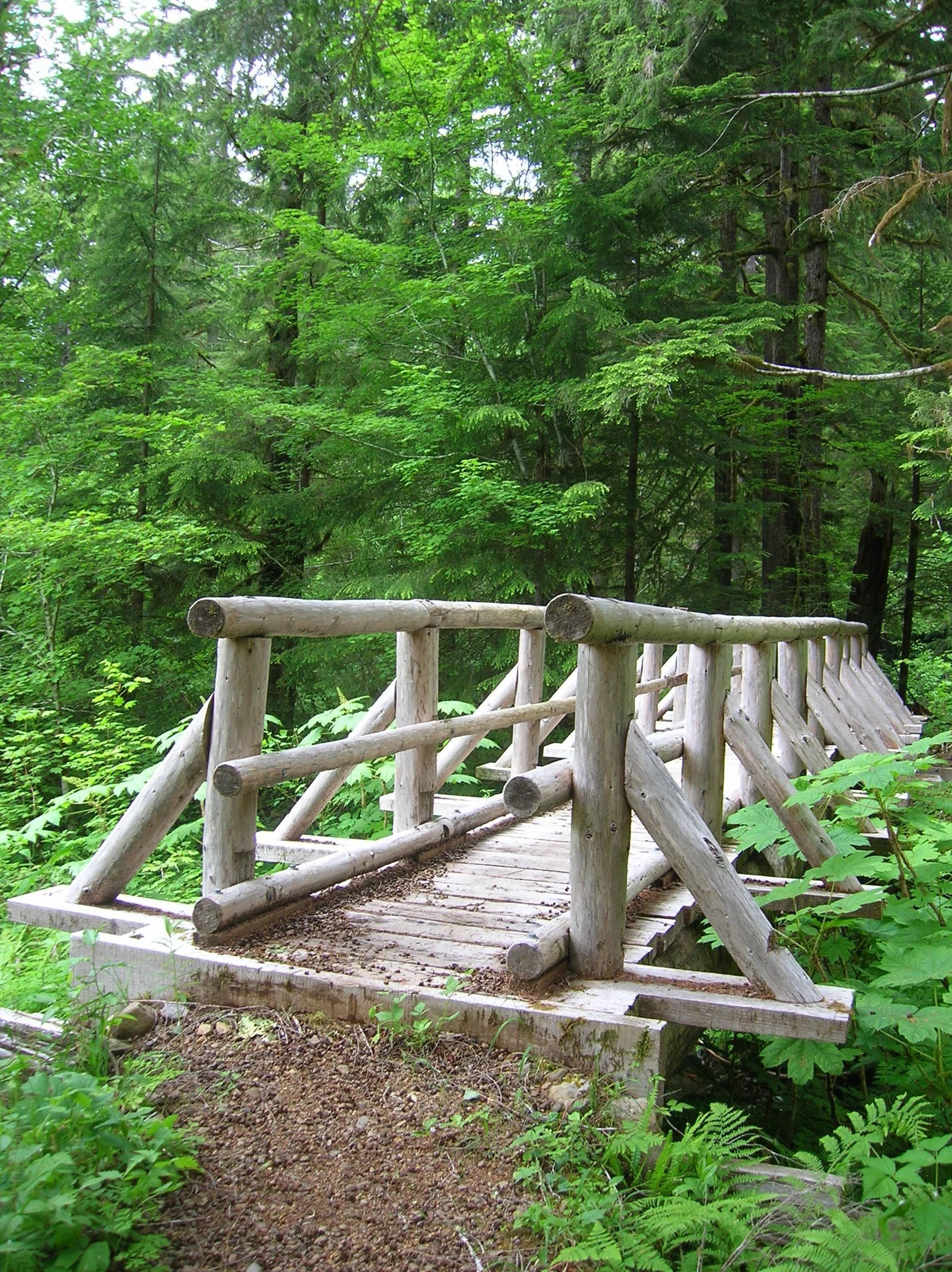
So is there an abundance of spiders at Spider Lake? No—no more than pretty much anywhere else in the Olympics. So what’s with the name? No one’s quite sure, as any record to how this lake got its name can’t be easily found. Spider Meadow in the Cascades Mountains is named after a mine, so that’s a possibility. Spyder Lake in Quebec and Spider Lake in Minnesota are named for their shapes resembling the arachnid. Is this lake shaped like a spider? No, it’s shaped more like a flatworm. Perhaps an early explorer simply named the lake after the arachnid because he had a spider encounter there—who knows?
In any case Spider Lake isn’t grand in any sense, this hike’s main draw is its trees. The lake is surrounded by gorgeous ancient forest—a tiny fragment of the grand forest that once shrouded the hills and ridges along this entire divide. The trail too is a fragment—once a much longer route connecting the South Fork Skokomish River Valley to the Satsop River Valley. Decades of intensive logging in this corner of Olympic National Forest not only obliterated the area’s primeval forest but also much of its extensive trail system.
With the cut now a fraction of what it once was and with trail usage at record numbers, it would be a great time to bring folks together to start rebuilding trails in the southern Olympic flank.
In the mid-1990s, trail builders resurrected a portion of the old trail that once traveled up the Cedar Creek valley and constructed adjoining new tread to build a two-mile loop around little Spider Lake. Trail-building aficionados will probably find the loop’s three large bridges noteworthy for their durability and aesthetics. Kids will love crossing them—probably doing a few repeats on the spans.
This trail is a joy to hike anytime of the year, but it glows pearly white in early summer when blossoming dwarf dogwood and queen’s cup blanket the forest floor. A few shrubs and sedges will add some golden touches in autumn. From the trail’s unassuming trailhead (there’s another unassuming trailhead to the south) immediately enter cool old-growth forest and come to a junction. Turn right (although either direction will work), crossing the outlet stream and soon reaching Spider’s western shoreline. Now saunter past towering trees, good fishing spots, and excellent viewpoints of the placid lake. Look for avian and amphibious residents. Cast your glances upward at the surrounding ridges. These intensively logged hillsides offer quite a contrast to the virgin groves cradling the lake.
After about a mile, cross a small creek and reach a junction. The trail heading right steeply climbs a short distance to an alternative trailhead. Continue left climbing a little above the green waters of the lake while being shaded by ancient behemoths. Now continue along the eastern shoreline climbing a bit more to traverse a steep slope.
After crossing a high log bridge, the trail begins its descent back to lake level. It then crosses an inlet stream in a marshy area before returning to the junction where you started your trip around the lake.
The hike is short, but the surroundings beckon you to slow down and enjoy the natural beauty of this small lake and its big trees. Perhaps you’ll be fortunate to see some wildlife along the way—and more than likely you probably won’t recall if you encountered a spider or two!
contributor
Craig Romano is an award-winning guidebook author whose deep connection to Washington trails, dedication to accuracy, and passion for conservation have made him a trusted name in the outdoor community. His contributions to Tracing the Fjord magazine bring rich, informed outdoor narratives to a readership that lives and loves the Hood Canal region. Craig's guidebooks stand out for their thorough research. He physically scouts trails, GPS-tracks routes, and includes lesser-known—and at-risk—options to offer diverse, accurate, and reliable resources for hikers. He incorporates sidebars with natural or cultural history and conservation insights in his writing. He emphasizes responsible use and stewardship of trails, challenging readers to be “good conservation and trail stewards.” Craig has written more than 25 guidebooks, including celebrated “Day Hiking” and “Urban Trails” series published by Mountaineers Books—featuring areas like the Olympic Peninsula, Vancouver BC, and beyond.
Crabby Characters: Stories from the Seafloor
Spend enough time beneath the surface of Hood Canal, and the silence starts to speak not in words, but in motion. Everything down there moves slower in the cold except the crabs. The crabs are always busy. Always urgent. I’ve watched one spend ten full minutes excavating a hole no deeper than a coin is thick, only to abandon it and scuttle off as if remembering something more important.
Thom Robbins | story and picturesSpend enough time beneath the surface of Hood Canal, and the silence starts to speak not in words, but in motion. Everything down there moves slower in the cold except the crabs. The crabs are always busy. Always urgent. I’ve watched one spend ten full minutes excavating a hole no deeper than a coin is thick, only to abandon it and scuttle off as if remembering something more important. One squared off with its own reflection in my camera dome, claws raised like a boxer waiting for the bell. And another cleaned algae off its shell, as if preparing for a first date.
They aren’t graceful like the kelp fish or hypnotic like moon jellies. They’re rough-edged little bulldozers, powered by instinct and old armor, constantly on patrol. You’ll find them under ledges, in discarded cans, perched on the pilings of a long-lost dock. Red Rock crabs, kelp crabs, decorator crabs, hermits dragging their spiral shells like tiny trailers behind them, all of them crawling, shoving, digging, sparring, eating, surviving.
To dive in Hood Canal is to enter their world, not as an observer but as a trespasser in a busy kingdom. And the deeper you go, the more you start to wonder: who’s really watching who?
There are over thirty species of crab living in the Salish Sea, and I swear I’ve startled half of them just getting my fins on. Big ones, small ones, legs like knitting needles—some so camouflaged they vanish if you look away. They're not background players down here. They're the quiet architects of the seafloor. Scavengers, cleaners, prey, and predators, they keep the submerged machine running.
Take the Dungeness crab. Everyone knows that name from a dinner menu, but out here, in the cold green quiet, you see the other side of it. These are not docile creatures. They fight like boxers in the sand, claw-to-claw. I once watched two square off over a fish head, each strike spraying up little clouds of silt. No hesitation, no mercy. The winner dragged the prize beneath a ledge and vanished. The loser waited a few beats, then started digging like it had never happened.
Red Rock crabs are the neighborhood bruisers, bad-tempered, road-shouldered, all edge. Their claws are darker than blood, twice as quick. You don’t want to get too close. They make sure you know when you’ve stayed too long.
Then there are the kelp crabs, graceful, spindly, with legs that seem to unfold forever. They cling to the long, swaying forests of bull kelp like sentries, their shells often coated in fuzz or film. I’ve seen them frozen in place for minutes, like a spider in a web—until they move. And when they do, they move fast.
But my favorite? The decorators. They’re the mad geniuses of the crab world—slow-moving and soft-shelled, but never unprepared. They tear pieces of sponge and algae from their surroundings, stitching them onto their backs like makeshift armor or fancy hats. Sometimes they vanish into the scenery. Other times, they look like moss-covered monsters crawling across the sand. I found one once with an entire anemone riding on its back, swaying as a crown.
Crabs do more than scuttle around at our feet. They oxygenate sediment, recycle waste, and form the base of countless food webs. Otters eat them. Octopuses hunt them. Even gulls have learned to flip them over like breakfast pancakes. But somehow, they endure.
Out here, beneath the weight of the water, they don’t feel small at all. They seem ancient, as if they’ve been here longer than we have. As if they know something we don’t, and maybe they do. Watch them long enough and you start to see why: crabs are built like tanks, only stranger. You don’t realize how alien they are until you’re face-to-face with one in the dark, thirty feet down. Your dive light catches the gleam off that hard, unblinking shell. They look back with stalked eyes, unmoving, weighing whether to run, fight, or decide you aren’t worth the thought.
Like spiders and shrimp, crabs are arthropods wrapped in an exoskeleton that is both armor and skeleton, with no bones inside and everything important protected on the outside. That shell, or carapace, is tough as old fiberglass, etched like a puzzle box, often scarred from past fights, and it doesn’t grow with them. When they get too big for it, they crack it open like a coffin and climb out soft and defenseless until the new shell hardens. I’ve found husks underwater that look like dead crabs until you realize they’re ghosts on the sand.
Most crabs have ten limbs, eight legs, and two claws, but don’t let the symmetry fool you. Those claws aren’t there just for show. They’re everything. I’ve watched crabs use them like tools, snapping open clam shells with surgical efficiency. I’ve seen them fight, claws locked like wrestlers on a mat, each trying to twist the other into submission. And once, on a night dive near an old piling field, I caught sight of a male crab slowly waving one claw back and forth in the beam of my flashlight, rhythmic, almost elegant, like conducting the tide. Mating display. Or maybe a warning. Hard to say. But whatever it was, it felt old. Practiced.
Even the Puget Sound king crab, the largest crab you’re likely to see in the Pacific Northwest, with a carapace that can span nearly a foot across, is unforgettable when you’re lucky enough to spot one. Its shell flashes red-orange under your dive light, edged with faint blue highlights as if brushed with frost.
Sometimes, you’ll notice asymmetry in its claws, with one noticeably larger than the other. This can happen after a molt, when a lost claw is still regrowing, or from years of favoring one claw over the other, like a boxer’s strong hand. That imbalance isn’t clumsy, it’s deliberate. Bigger doesn’t always mean better, but it does mean louder. That oversized claw speaks before the crab ever moves. It says: I’ve survived something you haven’t. I’ve fought. I’ve rebuilt.
Many of them have. Crabs here lose claws to predators, traps, and each other, but they don’t stay broken. They molt, wait, and grow it back slower, a little different, but the same. When you see that heavy claw raised like a crooked banner, it’s not just a weapon, it’s a story of survival, hard-won and costly.
Down here, everything fights to keep going—sometimes with teeth, sometimes with venom. Crabs fight with whatever they’ve got left, rebuilding one joint, one muscle fiber at a time. There’s an honesty in that brutality.
You never forget the first time you see a crab run. It’s not a graceful thing. Not smooth like a seal gliding past or a school of herring flickering in unison. It’s sharp. Sudden. Like something went off inside it. One second it’s there, perfectly still, and the next it’s gone—vanished sideways into the shadow of a rock or beneath a curtain of eelgrass.
That sideways sprint comes from design. A crab’s legs hinge on the sides, not underneath like ours. Each leg pushes like an oar, catching the bottom and shoving the body across the sand with precision. When you see it up close, there’s a rhythm to it, like a dancer on a single beat.
And when they move, they move faster than you'd think. The crabs here in Hood Canal—Red Rock, Dungeness, and the occasional Northern Kelp Crab aren’t built for land speed, but underwater? They’re spring-loaded traps. One second, they’re still, blending into sand or clinging to a piling; the next, gone. Just a blur of motion and a trail of stirred-up silt.
I’ve watched a Dungeness bolt sideways across a sandy shelf with such force it left a trench behind, vanishing beneath a ledge before I could even lift my camera. Kelp crabs don’t move quite as fast, but when they do, it’s sudden, those long, delicate legs pulling their mossy bodies up and over kelp blades like they’re trying to escape the light. Helmet crabs and graceful kelp crabs can vanish into the gloom in a blink if you come too close.
They don’t waste energy, every movement counts. When they go, it’s all at once, like something spooked in the woods, sharp and armed.
I’ve chased more than a few across the bottom camera in hand, bubbles rising just trying to land one clean shot. But more often than not, all I’m left with is a cloud of sand and a shape disappearing into shadow. That’s the game—they always win.
Not all of them run. Some freeze, legs tucked tight, trusting camouflage to outlast your curiosity. Decorator crabs are masters of this—covered in algae, sponges, and stitched-on debris, they hold so still you doubt they were ever moving at all. You notice them only when they twitch once, like something from a dream that leaves no footprints.
Others bluff. The Red Rock raises its claws in defiance, even when outmatched, daring you to come closer. And I’ve seen graceful kelp crabs pull themselves into near-vertical poses, legs extended, trying to look bigger. They don’t want to fight, but they’ll make you think.
Then there are the burrowers, smaller crabs like helmet crabs or hairy shore crabs. When spooked, they vanish downward instead of outward, kicking up sand as they wedge themselves under rocks or into old clam holes. They disappear.
Every crab makes a decision in that split second before it moves: fight, freeze, flee, or fade. They don’t choose wrong more than once. Here, hesitation means you get eaten. And if you’re lucky and quiet, you get to watch them make their choice. When they stop—when they finally wedge themselves beneath a rock or vanish into the reef’s contours—they don’t pant or pulse like a fish might. They just stop, as if nothing ever happened.
Down here, it’s not the fastest creature that survives. It’s the one that knows when to run, how to vanish, and what angle to take when it does. Crabs figured that out a long time ago.
The eyes are the first thing you notice, two dark marbles on stalks, swiveling like radar dishes in the murk. They move independently, scanning front and back at the same time, and it’s unsettling in a way I can’t quite shake. I’ve knelt in the silt, barely breathing, and watched a crab watch me, one eye fixed on my mask while the other seemed to scan the reef behind it, like it was calculating the best escape route. Or maybe waiting to see what I’d do next.
But crabs aren’t just watching. They’re communicating in ways most people never notice. They tap, drum, raise, and wave their claws in deliberate patterns, not just to warn or threaten but to talk. Males might flash their chelae, the front claws built like living pliers—part weapon, part tool—each ending in a sharp, hinged pincer. Look at me. I’m strong. I’m ready. Don’t come any closer. It’s a kind of semaphore, silent and specific, evolved not for show but for survival. Some species send messages through the seafloor by drumming with their legs.
The closer you look, the more the body itself becomes a language.
Beneath that armored face, their mouthparts are hidden in plain sight, tucked up under the shell like something secret. Most people never notice them. But divers have time. We wait. We watch. And if you’re patient, you’ll see those tiny, feathered appendages in constant motion, pulling in food, sorting it, filtering it, working like a factory line. It’s never still. Even when a crab looks motionless, it’s chewing through the world one particle at a time.
And they’re not picky. Crabs are opportunistic feeders—algae, plankton, fish scraps, rotting kelp, even other crabs if the tide turns cruel. I’ve seen it happen fast, almost clinical. No ceremony. No malice. Just need.
They speak through motion, posture, and action, enough where sound doesn’t carry and light doesn’t last.
Beneath the shell, hidden to most, lies one of the weirdest parts of crab biology: they breathe through gills, just like fish. The gills are tucked into chambers beneath the carapace, kept moist by leg movements and flaps called scaphognathites that pump water over them. I’ve seen crabs dug into damp sand during low tide, perfectly still but alive, waiting for the tide to return.
Here's something most folks don't realize: you can tell male and female crabs apart by flipping them over. Males have a narrow, pointed abdominal flap; females have a broad, rounded one shaped like a dome. That’s where they carry their eggs, thousands packed tight like orange caviar, gently fanned with back legs to keep oxygen flowing. It’s a strange kind of tenderness, watching it happen underwater. There’s something ancient about it. Something careful.
When you see a crab crawling across the bottom, it’s easy to think of it as just another bit of marine clutter, another scuttling shape in the gloom. But inside that shell is a creature perfectly engineered for survival, part armor, part instinct, part mystery. The more time I spend with them, the more I believe they’re not just part of the seafloor. They are the seafloor, living, crawling, biting proof that nature doesn’t waste time on beauty when function works better.
And still, somehow, they're beautiful.
Crabs aren’t just skittering distractions; they’re survivors in a complex life cycle that begins as floating larvae barely bigger than plankton. After hatching, young crabs go through multiple molts, shedding their exoskeletons to grow. These larval forms, called zoeae, drift with the currents—tiny, vulnerable—before settling to the bottom where the real battles begin.
Molting continues in adulthood. During these soft-shelled interludes, crabs are most vulnerable. Many hide in the sand or under rocks. For females, it’s the only time they can mate, making it a moment of both risk and opportunity.
Once fertilized, females carry eggs on their undersides like a clutch of orange grapes. Watching a crab fan her eggs with rhythmic leg flicks reminds you that even armored creatures tend their young with surprising delicacy.
Not all eggs survive, and not all crabs do either. For every empty shell tumbling in the current, another waits just out of view, ready to take its place.
As a diver, I’ve learned that the best moments often happen in the periphery. You come for the wolf eel or the octopus, but you stay because something small scuttles in and steals the show. Crabs are like that, endlessly watchable, hard-wired to move, eat, and thrive.
Next time you’re under the surface or in a tidepool, watch a crab at work. There’s a world in those legs, strange and alive as anything in the sea. A reminder, we’re only visitors in their kingdom.
Thom Robbins Bio
I am fascinated with the underwater world here in the Pacific Northwest. I have been a diver for over thirty years and have never been happier than underwater with a camera. I spend as much time underwater as possible, writing, shooting pictures, or teaching diving and photography. You can learn more about me at https://www.thomrobbins.com.
When not diving, I spend time with my wonderful, patient wife, Barb. We live in Shelton, Washington, where we relish a relaxed lifestyle close to world-class diving spots. Barb’s support has been instrumental in my passion for diving; she is my best and often harshest critic, constantly pushing me to capture better photos. Our 21-year-old son inspires me to be a better person every day. Completing our family are our two English Bulldogs, who bring us endless joy.
5 amazing hikes around Hood Canal
While there is plenty of news coverage following the devasting Bear Gulch fire near the Staircase Entrance to the Olympic National Park, don’t give up on your plans to visit the Hood Canal region to explore the many amazing hikes and trails in the area.
Update: July 29, 2025 – Until recently smoke conditions have remained “good.” As of 7/29/2025. fire activity has increased in three areas that have impacted Staircase Region and Olympic National Park as well as Upper Skokomish Valley and Hama Hama Recreation Areas. There is now increased smoke and conditions are unhealthy for some individuals in the immediate area.
Award winning local guidebook author, Craig Romano, shared 25 of his top area hikes with us in a handy “stuff-in-your-glovebox guide,” here are a few of the many hikes that are open and awaiting your adventure! Welcome to the #wildsideWA.
Tighten your laces!
1. Murhut Falls
(Olympic National Forest)
Hidden in a lush narrow ravine, Murhut Falls were long unknown to many in the outside world. But all that changed upon the construction of a well-built and easy to hike trail. This two-tiered waterfall that plummets 130 feet has become a favorite cascade for many Olympic Peninsula hikers. The trail starts by following an old well-graded logging road. As you work your way toward the falls, its roar will signal that you’re getting closer. Reach the trail’s end and behold the impressive falls crashing before you. The upper falls drops more than 100 feet while the lower one crashes about 30 feet.
Difficulty: Easy, 300 feet elevation gain, 1.6 miles
Permits: Not required
Kid and Dog Friendly: Yes
2. DuckabusH River trail
(Olympic National Forest)
The Duckabush River starts in the heart of the Olympic Mountains and flows through a deep verdant valley on its way to Hood Canal. Duckabush River Trail travels near and along the river for more than 20 miles terminating at Marmot Lake in the heart of Olympic National Park. At a little over 3 miles you will come to a ledge with a spectacular view east down the river valley. On a clear day you can see all the way to the Cascades.
Highlights: Old-growth forest, low elevation wilderness valley, backpacking opportunities
Distance: Moderate, 10.6 miles R/T Elevation gain: 2150 feet
Permits: NW Forest Pass /Interagency Pass
Kid & Dog Friendly: Yes
Duckabush River
3. LENA LAKES TRAIL
(OLYMPIC NATIONAL FOREST & PARK)
With all the fire activity this iconic trail system remains far removed from the bustle. The Lena Lakes are located above the Hamma Hamma valley. Despite having the same name, the two lakes have distinct differences. The lower lake is a simple, family and pet-friendly walk through old, tall trees in Olympic National Forest. The upper lake is a tough climb to a beautiful high area in Olympic National Park. The lower lake can be busy with hikers on a summer Saturday while the upper lake offers more solitude. Access to both lakes is the same.
Highlights: Old-growth forest, water!
Distance: Lower: 6 miles R/T; Upper: 14 miles R/T
Elevation gain: Lower: 1225 feet; Upper : 4100 feet
Difficulty: Lower Lake: moderate; Upper Lake: strenuous Permits: Northwest Forest or Interagency Pass
Hiking Season: Lower Lake: March to Dec; Upper Lake: July to November
Notes: Camping (no fires) at Upper Lake requires National Park Wilderness Camping Permit (contact Olympic National Park, Wilderness Information Center (360) 565-3100)
Kid-Friendly: Yes Lower Lake; no Upper Lake Dog-Friendly: yes Lower Lake; prohibited Upper Lake
4. spider lake
(Olympic National Forest)
A long slender lake tucked within a narrow valley on the Skokomish–Satsop River divide, Spider is graced with groves of ancient giant old-growth forest. The trail around the lake is a remnant of a longer trail that once traversed miles of primeval trees. Most of those trees have since been logged, and the trail truncated to the lake. The remaining trail has since been restored and the forests on the surrounding hillsides are regenerating nicely.
Highlights: Old-growth forest Distance: 2 mile R/T Difficulty: Easy Elevation gain: 250 feet
Permits: None
Kid and Dog Friendly: Yes
5. Schafer Forest Trail
(Schafer State Park)
Tucked along the East Fork Satsop River in extreme southwestern Mason County, Schafer State Park is off-the-beaten path. While this park is far from population centers, it was a thriving spot for many years. In 1872 the Schafer Family came from Wisconsin to homestead here. Three of their sons, Peter, Albert and Hubert begin logging the homestead in the 1890s. They donated this parcel to the state in 1924, and it continued to host many large company gatherings as well as other groups. Today the park is much quieter, but families still come here to gather. The park’s trails however tend to remain pretty peaceful.
Highlights: Historic homestead; trail along Satsop River; salmon spawning creek and estuary
Distance: 1.3 mile loop Elevation gain: 75 feet
Difficulty: Easy Permits: Discover Pass Kid & Dog Friendly: Yes
This is only a SMALL sampling of the amazing hikes available in the area! Check out the hikes link for a full list of places to explore, visit the waterfalls trail for a comprehensive list of year-round waterfall destinations — or pick up or download a copy of Romano’s Top 25 Hikes!
Sacred Waters Retreat in Union WA | Healing, Art, and Community Above Hood Canal
Welcome to Sacred Waters Retreat, a hidden sanctuary perched above the shores of Hood Canal in Union, Washington. Formerly known as Harmony Hill, this sacred space has been a source of healing, reflection, and community for nearly four decades. With a legacy rooted in cancer retreats, grief support, yoga, and meditation, Sacred Waters continues that mission, now with open arms to the entire community.
Welcome to Sacred Waters Retreat, a hidden sanctuary perched above the shores of Hood Canal in Union, Washington. Formerly known as Harmony Hill, this sacred space has been a source of healing, reflection, and community for nearly four decades. With a legacy rooted in cancer retreats, grief support, yoga, and meditation, Sacred Waters continues that mission, now with open arms to the entire community.
This video tells the story of Sacred Waters’ transition, from its beginnings as Harmony Hill to its preservation through the generous support of local donors and its new stewardship by St. Andrew’s House. You’ll hear from longtime facilitators, volunteers, and artists who share how this land continues to inspire peace, transformation, and connection.
From the 150-year-old sequoia at the heart of the labyrinth to the windphone, where visitors can speak to loved ones who’ve passed, every inch of this eight-acre property invites stillness and renewal. Visitors can walk the gardens, attend a retreat, volunteer, or simply sit in the shade and take in panoramic views of the Olympic Mountains and Hood Canal.
As part of its new community outreach, Sacred Waters is hosting its first Art & Community Fair on July 20, 2025, from 11 AM to 4 PM. This free, family-friendly event features live music from Chris Eakes, handmade works from regional artists, delicious food by Kern’s Kitchen, and booths from organizations like the YMCA, Mason County Historical Museum, and the Hood Canal Improvement Club.
Whether you’re looking for a quiet place to reflect or a new way to connect with your neighbors, Sacred Waters is here for you. Everyone is welcome.
Loblolly Lavender Farm: A Peaceful Bloom in Shelton, Washington
Experience the sights, scents, and serenity of Loblolly Lavender Farm—a hidden gem in Shelton, Washington. With over 2,000 vibrant lavender plants, handmade products, and a charming on-site shop, this locally grown family farm is the perfect escape.
Experience the sights, scents, and serenity of Loblolly Lavender Farm—a hidden gem in Shelton, Washington. With over 2,000 vibrant lavender plants, handmade products, and a charming on-site shop, this locally grown family farm is the perfect escape.
In this video, Keith and Tracy Cook share the story behind Loblolly—from planting the first rows to welcoming over 1,000 guests at their first festival. Learn about the different lavender varieties, their calming and healing benefits, and how you can pick your own bouquet, sip lavender tea, and browse small-batch skincare and syrups all summer long.
Discover the Magic of Sunrise Resort on Hood Canal – A Pacific Northwest Hidden Gem
Tucked along the pristine shores of Hood Canal, Sunrise Resort is more than a destination—it’s a tradition. With stunning waterfront views, unmatched diving access, and deep roots in the Hoodsport community, Sunrise offers adventure, tranquility, and unforgettable memories for families, travelers, and divers alike.
Tucked along the pristine shores of Hood Canal, Sunrise Resort is more than a destination—it’s a tradition. With stunning waterfront views, unmatched diving access, and deep roots in the Hoodsport community, Sunrise offers adventure, tranquility, and unforgettable memories for families, travelers, and divers alike.
In this video, meet the people behind the transformation of this iconic resort, explore breathtaking footage of its natural surroundings, and hear why divers from around the world call this place home. Whether you're planning a weekend getaway, a dive retreat, or just want to reconnect with nature—Sunrise Resort is your gateway to the best of the Pacific Northwest.
Explore The Glen — where adventure begins and comfort meets the beauty of Washington’s Hood Canal.
Nestled between forest and fjord, The Glen is your ultimate base camp for outdoor escapes, weekend retreats, and unforgettable getaways. With 14 hotel rooms (including pet-friendly options), luxury suites, a vacation rental, and full RV hookups, you’re perfectly positioned to explore the Olympic National Park, Staircase, Lake Cushman, and beyond.
Nestled between forest and fjord, The Glen is your ultimate base camp for outdoor escapes, weekend retreats, and unforgettable getaways. With 14 hotel rooms (including pet-friendly options), luxury suites, a vacation rental, and full RV hookups, you’re perfectly positioned to explore the Olympic National Park, Staircase, Lake Cushman, and beyond. From free coffee and waterfront jacuzzis to deep-water diving and forest trails, The Glen blends rustic charm with modern amenities. Whether you're hiking, kayaking, oyster tasting, or just relaxing by the fire pit—this is where your story begins.
Escape to Jarrell Cove State Park | Harstine Island, WA
Located on the northwest tip of Harstine Island in Mason County, Washington, Jarrell Cove State Park is a peaceful, saltwater playground with forested campsites, moorage for boaters, and plenty of space to kayak, paddleboard, or unwind by the water.
Located on the northwest tip of Harstine Island in Mason County, Washington, Jarrell Cove State Park is a peaceful, saltwater playground with forested campsites, moorage for boaters, and plenty of space to kayak, paddleboard, or unwind by the water.
In this video, Jeff Slakey from Explore Hood Canal explores the park with Ranger Liesl Plomski and Park Aid Lucas Marin to uncover its hidden history, local wildlife, and everything that makes Jarrell Cove one of the South Sound’s best-kept secrets.
From Logging Legacy to Natural Escape – Discover Schafer State Park
Take a journey through time and trees at Schafer State Park — one of Washington’s original state parks, founded in 1924 by the Schafer Logging family. Set along the beautiful Satsop River near Elma, this park blends rustic WPA-era craftsmanship with brand-new campgrounds and cabins.
Take a journey through time and trees at Schafer State Park — one of Washington’s original state parks, founded in 1924 by the Schafer Logging family. Set along the beautiful Satsop River near Elma, this park blends rustic WPA-era craftsmanship with brand-new campgrounds and cabins. In this feature, we explore the park’s rich logging legacy, the flowing Satsop, modern upgrades, and the peaceful recreation that keeps visitors coming back year after year.
HOODSTOCK 2025 | UNION, AUGUST 15–16
The 8th Annual Hood Canal Music and Art Festival (Hoodstock) in Union, Washington is not just a lineup of modern performances—it’s a heartfelt homage to the illustrious artist colony that has defined this region since the early 1900s.
Hoodstock Kickoff!
Friday, August 15 | 6pm - 10pm
Robinhood Village Resort, Union WA
Ticketed Event / 21+ over only (tickets available at www.hoodstock.org)
Lineup:
6pm - 6:45pm Liquid Horse
7pm - 7:45pm Lavon Blue Band
8pm - 10pm 5 Guys 1 Flute
Hoodstock Water Concert!
Saturday, August 16 | 12pm - 6pm
Union, WA
Boat launch: Union Marina, 5101 WA-106, Union, WA 98592
Lineup:
12pm - 1:30pm Cody Bartels and the Evergreen Playboys
2 pm - 2:30 pm Lovely Colours
4pm - 6pm Nearly Dan
Your flag is your ticket! Flags are available for purchase at the Union Country Store, May Mobile Marine, and Summertide Resort.
Hoodstock Land Festival!
Saturday, August 16 | 12pm - 4pm
Robinhood Village Resort, Union WA
Free admission from 12 pm - 4 pm, all ages | 15+ artisan vendors & food trucks!
Lineup:
12pm - 12:45pm Steve Beck
1pm - 1:45pm Biff Moss
2pm - 2:45pm Captain's Lounge
3:15pm - 4pm The Grit Band
6pm - 10pm
Robinhood Village Resort, Union WA
Ticketed Event / 21+ over only (tickets available at www.hoodstock.org)
Food and beverages available!
Lineup:
6pm - 7:30pm The Lumen
8pm - 10pm Garage Heroes
Flag Purchase: Flags are available at the Union Country Store, May Mobile Marine, and Summertide Resort.
For tickets and more details on each event, be sure to visit hoodstock.org and be ready to celebrate a dynamic heritage that blends “Then to Now” in a spectacular showcase of music, art, and history.
Orre Nobles at Olympus Manor
Step into a rich tapestry of art, music, and history as Hood Canal pays tribute to its creative roots this summer. The 8th Annual Hood Canal Music and Art Festival (Hoodstock) in Union, Washington is not just a lineup of modern performances—it’s a heartfelt homage to the illustrious artist colony that has defined this region since the early 1900s.
Long before the bohemian artists made “Union City” their home, the shores of Hood Canal were home to Native American tribes. Through carving, weaving, music, and storytelling, Hood Canal's first peoples expressed a connection to the land and waters, laying a foundation for a region defined by creativity.
The early 20th century saw the rise of flourishing art communities along Hood Canal, none more captivating than the Artist Colony of Olympus Manor. From 1924 to 1952, Olympus Manor was a beacon for the arts, attracting painters, sculptors, and bohemians alike. At the center of this vibrant colony was Orre Nobles, whose influence and passion for art continues to inspire present artisans.
Union's August festival embraces the theme “from then to now – the path to Hoodstock.” It’s a celebration of creative journeys that started in the early decades of the last century and continue to evolve in a modern landscape rich with musical and artistic expression. The festival offers an immersive experience that bridges eras with unique events planned to enchant both loyal art devotees and curious newcomers alike.
Honoring the Past: Revel in the rich history of the Olympus Manor artist’s colony spotlighting works and narratives that bring to life the era of Orre Nobles, Frank Pixley and Waldo Chase.
Embracing the Present: Performances by rising artists and musicians, blending genres and styles in a way that pays homage to past innovations while paving the way for future creative endeavors
Celebrating the Future: With diverse musical acts on land and at sea, the festival’s multiple stages ensure there is something for every art and music lover.
Mount Rose: Summer hike with a climb
This hike is one of the steepest in the Olympics but with a blanket of wildflowers and stunning views, it is well worth the climb! With a nod to William Shakespeare, that which we call Mount Rose by any other name would still be as steep!
Story and pictures: Craig Romano
This hike isn’t terribly long. And its trailhead is fairly easy to reach via mainly good paved roads. The trail traverses impressive towering old-growth forest. And in summer wildflowers brighten the forest floor and decorate summer ledges. Views? They’re stunning, especially of Lake Cushman sparkling 3,500-feet directly below. But every rose has its thorn. And for Mount Rose, all of this natural beauty and splendor comes at a steep price—literally. This hike is one of the steepest in the Olympics.
Hit the Trail
Yes, the trail up Mount Rose is grueling. But it makes this hike all that much sweeter by weeding out the crowds. Rose makes for an excellent quieter alternative to nearby Mount Ellinor. And being more than 1,000 feet lower than that popular peak means a longer snow free hiking season on Rose. And while handfuls of hikers may swear off this mountain—plenty swear by it and swear on it while going up it. They embrace its steepness as a great conditioner for harder hikes planned later in the season. In any case, do not under estimate this hike. Trekking poles will significantly help—especially on the insanely steep descent. And take plenty of water.
The trail starts out deceptively easy on a fairly level traverse along the base of the mountain. After crossing a pair of cascading creeks and passing a square-shaped builder shrouded in ferns the way gets down to business. A seemingly endless procession of switchbacks will keep you occupied. And if you think the going is steep—it used to be steeper! The all-volunteer Mount Rose Trail Crew reconfigured and rebuilt much of this trail several years ago, making it much more negotiable. The Mount Rose Trail Crew has left their positive marks on many of the trails in the Lake Cushman area.
Much of the lower mountain is covered in uniform second growth forest thanks to fires early in the last century. But a handful of surviving towering old-growth giants break the monotony of the younger forest. The trail enters the 13,000 Mount Skokomish Wilderness, one of five wilderness areas in Olympic National Forest flanking Olympic National Park. At just shy of 2.0 miles (although it may feel a lot longer) the trail reaches the summit loop junction. Here a small plaque honors the crew that built this trail.
Which direction you take the loop is dependent on your preference. The way left is much steeper which for many is easier to ascend than descend. But if you head right instead you will reach the scenic payoff later—prolonging the anticipation. Most folks head left first to tackle 1300 feet of ascent within a mile. The way relentlessly climbs passing through dark moist forest before transitioning to a forest recovering from a 2006 wildfire. At 2.9 miles from the trailhead reach the 4301-foot open-forested summit. Your attention will be immediately drawn to sparkling Lake Cushman below. It’s a breathtaking view of the large lake cradled by steep emerald slopes. But do scan the lake’s surroundings too admiring Lightning Peak and Timber Mountain rising majestically above it. Take in views too of Wonder Mountain and Church Peak to the southwest; and the Skokomish delta, Black Hills, Willapa Hills, and Mount Rainier to the south. And catch glimpses through silver snags and white pines of the deep valley of the North Fork Skokomish River.
After admiring the stunning views, continue on the loop along a narrow forested ledge. Along the way you’ll be greeted with more fine views including close ups of Copper Mountain towering above you and Hood Canal in the distance. The way then enters impressive old-growth forest and passes a fascinating colonnade of four silver firs. They’ve grown so close together they appear fused. The summit loop will deliver you back to a familiar junction from where a brutal descent will deliver you back to the trailhead.
Mount Rose’s views are indeed sweet. But the mountain’s summit floral show can be equally stunning. The mountain however is not named for roses, of which four native species grow in the Olympics. The mountain takes its name from Alfred A. Rose, who in 1885 arrived in the valley below with his wife and three children from California. Rose was one of the first non-native settlers in the valley, claiming 150 acres along Lake Cushman. But his tenure here was short. He succumbed to small pox four years later. In 1926 the lake was dammed greatly increasing its size and inundating Rose’s original homestead as well as other early settlements. I’m not sure if Rose ever grunted to the summit that bears his name. But with a nod to William Shakespeare, that which we call Mount Rose by any other name would still be as steep!
Bluegrass from the Forest Celebrates 20 years!
This three day outdoor music festival is fun for the whole family with headliner national bands daily, workshops, kids activities and programs and event a Saturday night dance!
July is an exciting time for Bluegrass fans in Mason County with the annual Bluegrass From the Forest festival at the Soccer Park on John's Prairie. This outdoor event fills the 15-acre park with music, workshops, and camping, making it a highlight of the Northwest Bluegrass scene. Celebrating 20 years in 2025, the festival includes a band scramble, workshops for kids, and a lineup of national and regional bands. With two stages, a beer and wine garden, food vendors, and ample camping spots, the festival is designed for families and people of all ages, offering workshops and tastings between performances.
The music ranges from traditional to more progressive bluegrass. The Festival’s program lineup features four major concerts highlighting top talent on the west coast. Saturday features "midnight hot-dogs" after the country dance. Camp jamming halts momentarily as the pickers and families join the musicians for a midnight feast in the main tent.
2025 Headliner Bands:
Seth Mulder & Midnight Run
Seth Mulder & Midnight Run, formed in 2018 in Tennessee's first legal moonshine distillery, mix tradition and innovation through authentic songs and thoughtful arrangements. Their music combines bluegrass, country, and folk, appealing to both traditional and modern listeners. They released their debut album, "Traveling Kind," in 2020 and followed up with "In Dreams I Go Back" in 2022 on Mountain Fever Records. Fans can look forward to new music in 2024, establishing the band as a true voice in roots and bluegrass music. Known as one of the most entertaining new acts in bluegrass today, Seth Mulder & Midnight Run is a band to see.
Never Come Down
Never Come Down is a band from Portland, Oregon that combines modern and traditional American music. They focus on meaningful lyrics and impressive arrangements. Formed in 2018, they released their first album, “Better Late Than Never,” in 2021. The band has toured globally and gained recognition at international festivals.
Midnight45
This talented band showcases impressive singing and playing skills. Based in Central and Western Oregon, Midnight45 focuses on deep-groove bluegrass music with a strong traditional style. They play both traditional and modern bluegrass, including original songs and classic country duets. Each member is an experienced musician, having performed in top bluegrass bands on the west coast.
Jim Hurst
Jim Hurst's distinctive guitar playing and bluegrass skills impress audiences and are admired by beginners and fellow musicians alike. His diverse career makes him an exceptional performer, a skilled teacher, and a sought-after session musician. Jim's friendly nature makes him easy to approach. He received the IBMA "Guitar Player of the Year" award in 2001 and 2002. After working with notable artists like Trisha Yearwood and Sara Evans, he started a solo career to showcase his own music. Jim has released 7 CDs and has been performing and teaching at workshops across North America and Europe for the past ten years. While he sometimes collaborates with other bluegrass artists, his solo acts and performances with the Jim Hurst Trio consistently captivate audiences.
The Oly Mountain Boys
The Oly Mountain Boys are a bluegrass band from South Puget Sound, performing in Olympia, Washington since 2008. They mix traditional songs with their own music, highlighting the strength of American bluegrass.
Way Far Yonder
Way Far Yonder is a new band from Eugene, Oregon. It features banjo player Henry Strid and champion fiddler Doug Fleener. They bring an energetic vibe with a classic fiddle and banjo sound.
Runaway Train Bluegrass
If you enjoy traditional bluegrass with a twist, you'll love Runaway Train Bluegrass! They are known for their harmonies and skillful playing. A popular band in the Pacific Northwest, they perform at special events when they can. They host the Bluegrass from the Forest festival and help organize it each year.
The Bar-K Buckaroos
The Bar-K Buckaroos will perform at the Saturday Night Country Dance, playing traditional western swing music like Bob Wills and his Texas Playboys. They mix Bluegrass, Country, Swing, Jazz, Blues, and Reggae for a fun night of music from the 20s to the 40s.
More than just great headiners! Fun for the whole family!
photo:Nancy Bay
The three day festival includes food, camping, and workshops, plus a Saturday night dance with free midnight hotdogs. It offers many activities for the whole family, including the popular Chick Rose School of Bluegrass for kids. This program starts Saturday morning and divides kids by skill level, allowing them to learn from experienced musicians and perform on the main stage. In addition to the bluegrass activities, there are various instrument and vocal workshops, concerts, and more throughout the weekend.
For additional details on band bios, ticket and camping reservations, visit bluegrassfromtheforest.com. Early Bird ticket pricing is available through until June 20.
Fjordin Crossin embraces tradition
Join the Hardware Distillery and Hood Canal Events to celebrate the annual crossing with a regatta and paddle race; music, food, kids' activities and an "Aquavit Grotto" under the pier.
Fjordin Crossin embraces an old world Scandinavian tradition of the spirit “aquavit”, with a series of unique events at the beach in Hoodsport, WA – a nordic parade, a barrel crossing, a family-friendly paddle race, drinks, vendors and food and, after the tide pushes the celebration back to the shore, the after-party continues on the streets of Hoodsport.
An Aquavit tradition
In 1805 a special brand of aquavit, Linie aquavit, crossed the Equator from Norway bound for the East Indies, unsold it returned to Norway in 1807. It turned out that the sea voyage had a positive effect on the taste of the spirit. The old sailing ships have vanished, but Linie Aquavit still crosses the Equator on the deck of a ship and returns via Australia. It has become a celebrated aquavit tradition.
Saturday, June 28, the Hardware Distillery will once again launch a barrel of aged dill aquavit to cross Hood Canal from Hoodsport to Tahuya and back. Although the journey will not take four months (the current sea rocking schedule of a traditional cask of Linie), each mouthful will contain the memory of its fjord voyage.
Paddle the Canal Challenge
Over the last half decade it has grown to include a non-motorized paddle across the canal challenge hosted by Hood Canal Events. Participants can bring their own watercraft, rent on site, or, if they have no desire to paddle but want to be part of the excitement --book passage on Lady Alderbrook from Alderbrook Resort, to cross Hood Canal alongside the barrel. On board the Lady Alderbrook aquavit cocktails are served, and participants take in the day’s festivities from the center of the action. Purchase advance tickets from Alderbrook Resort and Spa (Union).
Ready to compete?
Learn more information, how to register and sign your required waiver. Kids 9 and under are FREE but must still register. This year's prizes include a night's stay in Hoodsport, a gift certificate to Hardware Distillery (get your Aquavit asap!), and goodies from our vendors. REGISTRATION FEE : Early bird rates until June 6 –, $30 adults/$15 kids (10-17). REGISTRATION CLOSES June 26 at 8PM to collect information and prep for the race!
To celebrate the launch, the Paddle the Canal “race” follows the barrel journey in canoes, kayaks, SUPs and small sailboats. Bring your own boat or rent from Hood Canal Adventures. The Paddle has partnered with HCE to offer same day kayak rentals onsite. Singles and Doubles available in advance.
Shore Side Activities
On shore there is plenty to do including vendors, oysters, a parade, artisans and children's crafts. The Aquavit Grotto serves cocktails on the beach as they await the arrival of the tide which will eventually send them to higher ground and move the events into the main street of Hoodsport where attendees will find additional activities offered by local businesses.
Schedule
11:00 AM – Food, libations, and vendors open at the Hoodsport Dock. Paddle the Canal registration open.
12:40 PM – Parade from the Distillery to the dock with the barrel of Aquavit. Led by Scandinavian musicians.
1:00 PM – Crossing the Fjord begins: Barrel of aged Dill Aquavit travels from the Port of Hoodsport toward Tahuya and back, and when it returns, the Aquavit has been Fjordin Crossin. The Paddle the Canal challenge begins.Family and pet friendly paddle comprised of canoes, kayaks, SUPs and/or small sailboats. The Lady Alderbrook arrives. Guests on the boat cheer on Paddle participants, and enjoy Hardware Distillery aquavit cocktails.
2:00 PM – Award ceremony and prizes for the Paddle Challengers.
3:00 PM – After party in Hoodsport. Visit the shops, restaurants, distillery and brewery.






Jellyfish : grace in the current
Gliding through the green summer currents, jellyfish seem to exist somewhere between matter and myth—elegant, translucent, and suspended in a world shaped by light and movement. Though often dismissed as pests or feared for their sting, these gelatinous invertebrates are a vital and beautiful part of the ocean’s marine ecology, especially during the warmer months
Thom Robbins | Story & picturesGliding through the green summer currents of the Salish Sea, jellyfish seem to exist somewhere between matter and myth—elegant, translucent, and suspended in a world shaped by light and movement. Though often dismissed as pests or feared for their sting, these gelatinous invertebrates are a vital and beautiful part of the Salish Sea’s marine ecology, especially during the warmer months.
At least 10 known species of jellyfish (Class Scyphozoa and Hydrozoa) are commonly found in the Salish Sea. However, the exact number varies depending on seasonal conditions and depth. The region also hosts a variety of hydromedusae, small jellyfish-like organisms from the class Hydrozoa and ctenophores (comb jellies), which are not true jellyfish but are often seen alongside them.
In the summer, diving in the Salish Sea isn’t about crystal-clear views but seeing what moves through the murk. As the surface waters warm, sunlight and nutrients combine to spark massive phytoplankton and algae blooms. These microscopic organisms flourish in the long daylight hours, turning the water cloudy green and dramatically reducing visibility.
At the same time, nutrient-rich upwelling from deeper waters feeds this explosion of life, creating a cascading effect through the food web. These blooms nourish jellyfish and other filter feeders, yet they can also trigger oxygen depletion in deeper layers—a process known as eutrophication. As algae and plankton die off and decompose, they consume oxygen, sometimes creating low-oxygen zones that drive fish and invertebrates like wolf eels into shallower waters, or out of the area entirely.
Despite the haze, the midwater teems with motion. Jellyfish pulse silently past in the filtered light, their delicate forms catching the sun like drifting ornaments. I’ve hovered motionless on some dives as dozens of moon jellies passed—some brushed softly against my mask. In those moments, the murk becomes a cathedral, lit not by clarity but movement. Among the most commonly seen is the Moon Jelly (Aurelia labiate). Recognizable by its delicate, bell-shaped body and the four horseshoe-shaped gonads visible through its dome, the moon jelly is both harmless and hypnotic. Although capable of stinging, its venom is so weak that divers typically feel nothing more than a light brush, if anything at all.
Another summer highlight is the Fried Egg jelly (Phacellophora camtschatica), which drifts through the current like a golden sun. Its yolk-colored center and frilled white tentacles make it one of the most photogenic creatures in the water column. Despite its size, it poses little threat to swimmers or divers. Less frequent but unforgettable is the Lion’s Mane jellyfish (Cyanea capillata)—the world's largest known jellyfish species. Its tentacles can grow over 30 meters long in Arctic populations, though those found in the Salish Sea are often smaller. Its sting is more noticeable, though rarely dangerous, and it tends to favor colder, deeper waters where few divers tread.
Jellyfish have been drifting through Earth’s oceans for over 500 million years, long before dinosaurs roamed the land or fish evolved bones. Fossil evidence shows that their basic body plan has remained remarkably unchanged, a testament to just how well-adapted they are to life in the water column. These ancient invertebrates are one of the oldest animal groups on Earth. Unlike many marine organisms, jellyfish never developed hard skeletons or complex organs. Instead, they relied on simplicity and flexibility: a hydrostatic body, a decentralized nerve net, and the ability to reproduce both sexually and asexually.
“Their survival lies in elegant simplicity. Jellyfish drift with currents, respond to light and nutrients, and reproduce quickly when conditions align—strategies that have carried them through five mass extinctions. Most jellyfish species live only a few months in their adult medusa form.”
In the Salish Sea, each summer bloom connects us to this deep evolutionary past. To hover among these creatures is to glimpse a lineage nearly as old as the ocean itself. Their movements may be fleeting, but their presence speaks to a legacy stretching back over 500 million years.
Built to Drift
Though they seem simple, jellyfish are highly specialized. With no bones, brains, or hearts, they are built to drift. The jellyfish found in the Salish Sea all share the same basic anatomy, but with fascinating variations.
At the center of a jellyfish’s structure is its bell, the umbrella-like dome that pulsates to move it through the water. This bell is made of a gelatinous material composed chiefly of water, up to 95% in most species. Radial canals branch from the stomach, distributing nutrients throughout the bell.
Larger predators also take an interest. Occasionally, ocean sunfish (Mola mola)—the world’s largest bony fish—wander into the Salish Sea, and jellyfish are a favorite food. Their thick skin protects them from stings as they chomp through even the largest medusae. Historically, leatherback sea turtles, specializing in eating jellyfish, may have traveled this far north, though sightings today are extremely rare.
Even other jellyfish can be predators. With its long, trailing tentacles, the fried egg jelly often feeds on smaller jellyfish that become ensnared in its stinging threads. It’s a quiet cannibalism, part of the natural food web.
Jellyfish can be an unexpected snack for juvenile salmon, especially pink and chum. These young fish sometimes feed on tiny jellies and jelly-like plankton as they migrate through the sea, supplementing their diets during their early life stages. When a jellyfish’s life ends and it sinks to the seafloor, crabs, sea stars, and other scavengers move in. They scavenge the soft tissue, recycling the jelly’s nutrients into the ecosystem.
For all their fragile, ghost-like appearance, jellyfish play a key role in the Salish Sea’s complex food web, both predator and prey. Their presence supports a range of species, many of which rely on these gelatinous drifters more than most people realize.
Unlike animals with hearts and blood vessels, jellyfish lack a true circulatory system. Instead, they rely on the simple structure of their bodies to move nutrients. Through a combination of internal canals and diffusion, the passive movement of molecules from areas of high concentration to low, nutrients are spread throughout the jellyfish's tissues. This efficient, low-energy system works because jellyfish are composed mainly of water and have thin, soft bodies, allowing nutrients and gases to move freely without blood or vessels.
Jellyfish lack a brain but rely on a decentralized nerve net to detect touch, orientation, and light. Around the bell’s rim are specialized sensory structures called rhopalia, which contain balance organs (statocysts) and light-sensitive spots (ocelli). These help jellyfish maintain their position in the water column and respond to environmental changes. In many species, like the Moon Jelly, you can see the four gonads (reproductive organs) through the bell. These are typically arranged symmetrically and give the jelly its iconic pattern. Jellyfish are usually gonochoric, meaning individuals are either male or female, though some species can change sex depending on environmental conditions.
Though they may appear delicate, jellyfish anatomy is an evolutionary success story, fine-tuned over half a billion years. Every structure, from the trailing tentacle to the light-detecting rhopalium, keeps these animals alive in a constantly shifting marine world.
Born of Water
Jellyfish have one of the most complex and fascinating life cycles in the animal kingdom, cycling between two distinct forms: the polyp and the medusa. Most of the jellyfish we see while diving are medusae—the free-swimming, bell-shaped adults. But before reaching this stage, each jellyfish begins life as a microscopic larva called a planula, which settles onto a hard surface and develops into a polyp. These polyps can remain dormant for years, cloning themselves and waiting for the right environmental cues—usually a change in temperature or light—to begin a process called strobilation.
During strobilation, the polyp stacks tiny disc-like ephyrae that break off and develop into juvenile jellies. This ability to clone and reproduce asexually means jellyfish can quickly take advantage of favorable conditions, leading to the massive blooms divers witness during Salish Sea summers. Some polyps may produce genetically identical clones, while others undergo sexual reproduction to introduce new genetic material.
In particular, Moon Jellies are known for their resilience and adaptability. They can tolerate low-oxygen conditions better than many other marine organisms, allowing them to thrive in increasingly stressed ecosystems. Crystal Jellies exhibit a unique form of reproduction in which males and females release gametes into the water column, a method known as broadcast spawning—one of the most ancient reproductive strategies in the ocean.
Hanging beneath the bell, a jellyfish’s tentacles and oral arms serve as its defense system and means of feeding. Along the tentacles are thousands of specialized stinging cells called cnidocytes, each containing a microscopic harpoon-like structure known as a nematocyst. When triggered by touch or the presence of prey, these structures fire, delivering venom that can stun or immobilize small organisms. Moon jellies don’t chase their meals—they drift with open arms through clouds of plankton, letting the current deliver each bite. Their tentacles sweep plankton, tiny crustaceans, and larval fish toward their fringe of short, frilly oral arms, transporting the food to the central mouth.
The fried egg jelly takes a slightly different approach. Its long tentacles snare zooplankton and smaller jellyfish, which are slowly drawn to its oral arms for digestion. Large and dramatic, it feeds with quiet efficiency, drifting through the current, letting the ocean deliver each meal. But while they drift and feed with effortless grace, jellyfish are also food for a surprising array of marine life. Sea anemones, rooted to rocks and pilings, often snatch passing jellies with their sticky tentacles. If a moon jelly drifts too close or becomes weakened, an anemone will pull it in, undeterred by the jelly’s stinging cells. Whenever I run across this it always looks like a child sucking in a plate of spaghetti.
Conservation
Although jellyfish are often seen as survivors—creatures that thrive where others struggle—they are also indicators of broader changes in marine ecosystems. In the Salish Sea, shifts in jellyfish populations can reflect changes in water temperature, nutrient levels, and even human impacts such as coastal development and pollution.
For instance, increased runoff from agriculture and urban development introduces nutrients that can intensify plankton blooms, indirectly supporting larger jellyfish populations. While this may seem like a success story for jellies, it often signals ecosystem imbalance. In extreme cases, jellyfish blooms can disrupt fisheries by clogging nets, consuming fish larvae, and competing with commercial species for food. Plastic pollution also poses a risk. Jellyfish sometimes ingest microplastics, mistaking them for prey, and may in turn be eaten by larger animals like salmon or sea turtles, passing toxins up the food chain. Interestingly, the translucent structure of jellyfish makes them particularly difficult to spot when entangled in discarded fishing gear, meaning they can suffer unnoticed in ghost nets.
Despite these concerns, jellyfish have become unlikely ambassadors for science, conservation, and discovery. One of the most important breakthroughs in modern biology came from the Crystal Jelly, found off the coast of Friday Harbor. Scientists discovered green fluorescent protein (GFP) in this species—a molecule that glows green under ultraviolet light. GFP acts like a molecular flashlight when inserted into other organisms, allowing researchers to track genes and observe biological processes in real time. This discovery revolutionized genetic and medical research, earning a Nobel Prize and highlighting the hidden value of marine life.
Conclusion
Encountering jellyfish while diving in the Salish Sea is never ordinary. Whether it’s a Moon's hypnotic pulse or a Crystal's rare glow, these animals embody a unique blend of grace, resilience, and ecological importance. They are living filters, slow-motion drifters, and seasonal storytellers, revealing much about the world beneath the waves. While some may still associate jellyfish with stings or beach closures, divers know better. To hover beside a jelly in its element is to witness nature in its purest form—unhurried, mysterious, and vital. In a time when ocean health is at risk, jellyfish remind us that beauty and science are not separate but intertwined. Their presence is more than a summer spectacle—it’s a quiet signal that even the oldest life forms still move among us, pulsing with stories the sea has never stopped telling. To witness one is to glimpse time suspended—fragile, pulsing, and older than memory








